Soviet Architecture in Georgia: 27 Monuments & Mosaics
Along with medieval monasteries, defense towers, soaring mountains, and early 20th-century Art Nouveau buildings, Soviet architecture in Georgia defines the country’s architectural appeal.
From monumental government buildings to intricate mosaics, Soviet-era design unexpectedly shaped the urban and rural landscapes. Many of these structures blend functionality with bold aesthetics, making them an interesting part of history and worth a slight detour when traveling across the country.


Classical, Modernist, and Brutalist architecture dominates much of Soviet Georgia’s urban or regional development. However, our version of that era’s architecture is slightly different, incorporating local elements—ornate details, geometric patterns, and even influences from traditional Georgian architecture motifs.
City planners left a lasting mark not only in the big cities but also in smaller towns and even villages. Therefore, Soviet architecture in Georgia differs from city to city.

There are probably hundreds of buildings and mosaics to talk about, so this guide concentrates on the fascinating examples of famous Soviet architecture in Georgia and my personal favorites, highlighting cultural houses, monuments, bas-reliefs, and mosaics all across the country I have been collecting through my travels across the beautiful places in Georgia.
Soviet architecture in Tbilisi differs from the rest of the country, featuring grand Soviet modernism, brutalist structures, and other memorabilia from the bygone era.

My ultimate guide to Soviet mosaics in Tbilisi discusses how the mosaic decorative art started in the Soviet Union, how Georgian mosaics differ from those of the other post-Soviet countries, and where to find the remaining works of art in the capital.
Disclaimer: Some of the links in this post are affiliate links, which means I may earn a small commission if you buy something through them—at no extra cost to you. It helps support my blog and lets me share real, first-hand travel tips. Learn more
Understanding Soviet architecture in Georgia
Since Georgia was part of the Soviet Union from its foundation until its collapse, i.e., for 70 years, the country has seen all the architectural styles and developments within its borders.
You can find buildings from the Stalinist era characterized by massive, grand, and eclectic designs to Khrushchevka residential buildings constructed to solve the country’s housing crises.
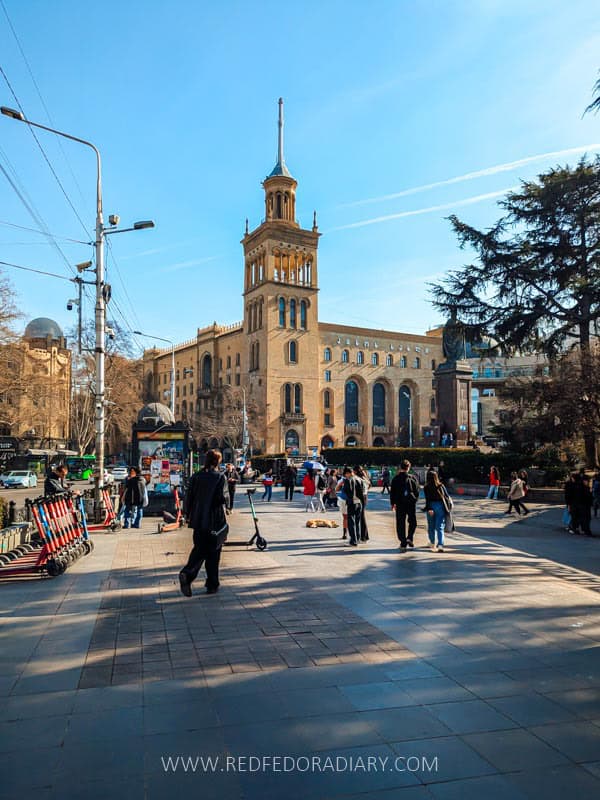

Georgian Soviet modernism, brutalist, and futuristic constructions won high prizes from the State and some even the USSR. They were vastly covered in various publications across the USSR and continue to have their momentum even today.
Colorfully decorated mosaics that attract an eye even from afar and intricate bas-reliefs are part of the modern Soviet architecture in Georgia.
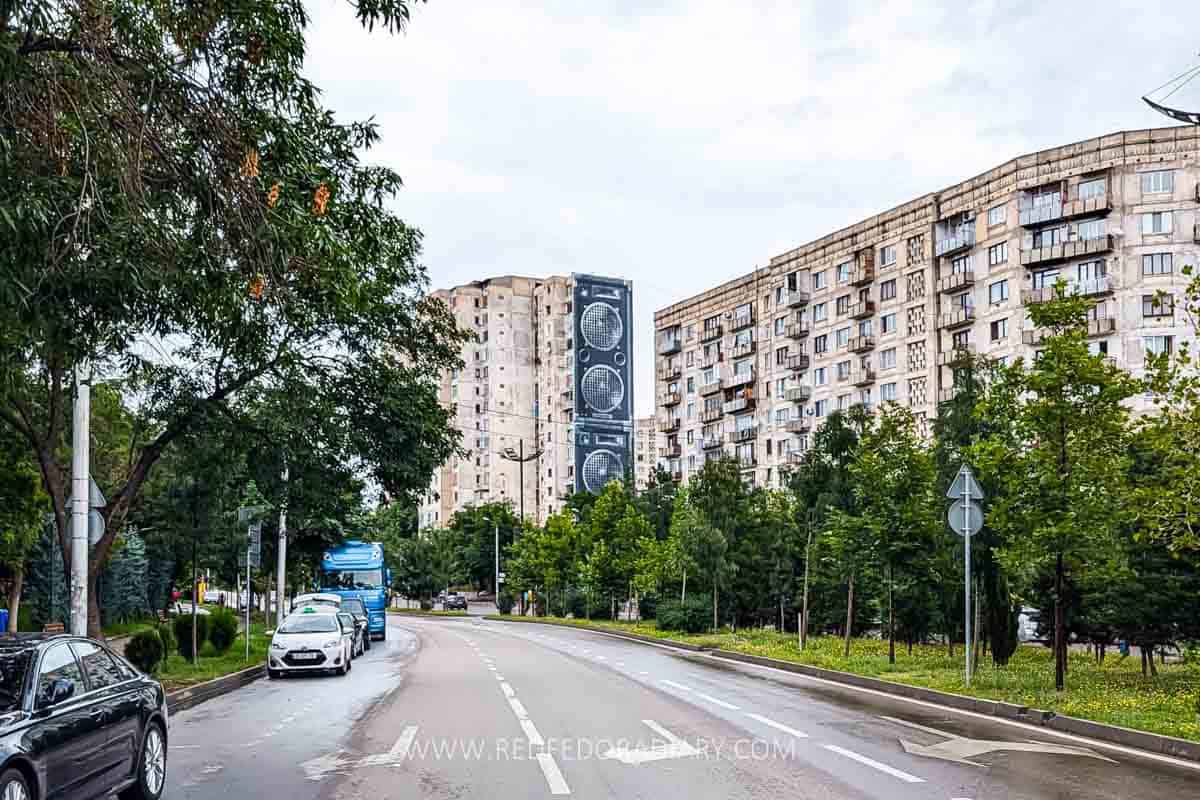
The government built colossal buildings in the prime agricultural villages where some Soviet-era administrative buildings are still in use in most cases and sometimes stand silent, abandoned, and in disrepair.
It also paid significant attention to arts and culture, constructing theaters and cultural houses nationwide, often featuring beautiful murals or intricate decor items.
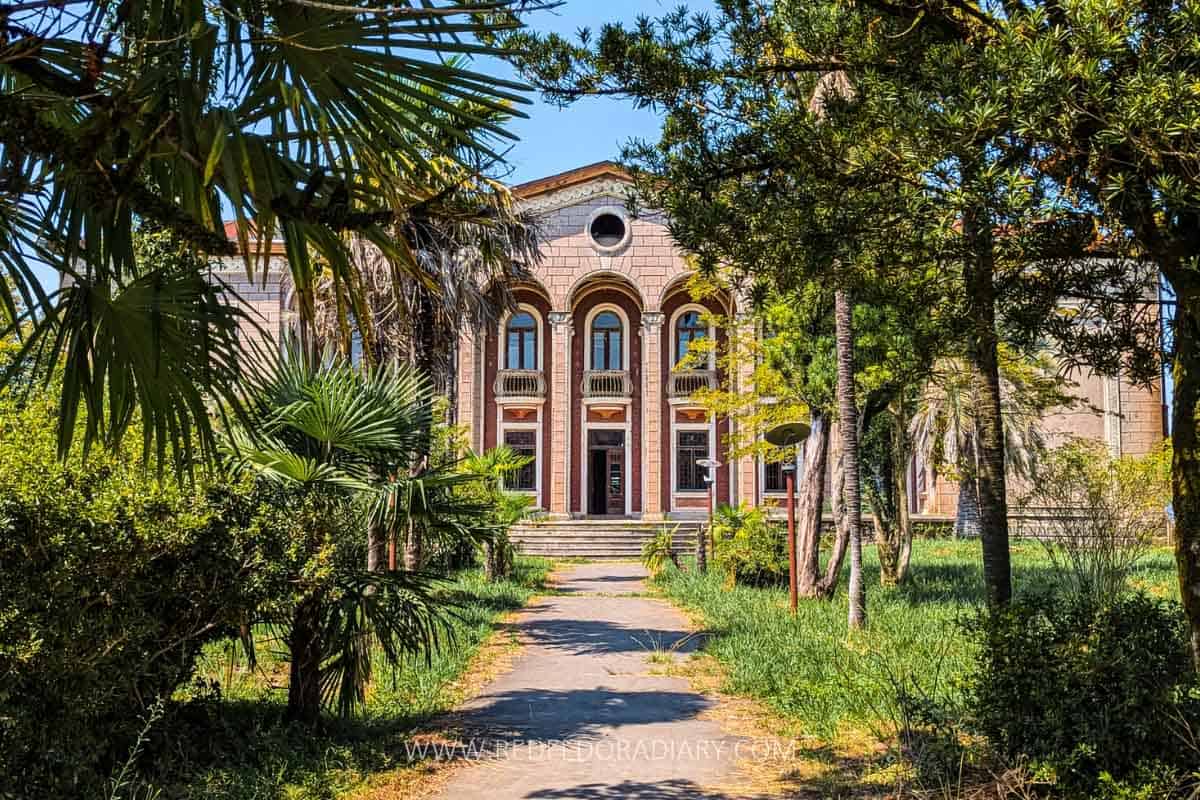
All these industrial, administrative, or cultural constructions served one simple purpose and ideology: to show its citizens the USSR’s order, power, and progress.
When mosaics became popular monumental art again in the 1960s across the Union, including in Georgia, they became a tool of propaganda, principles, and artistic expression.
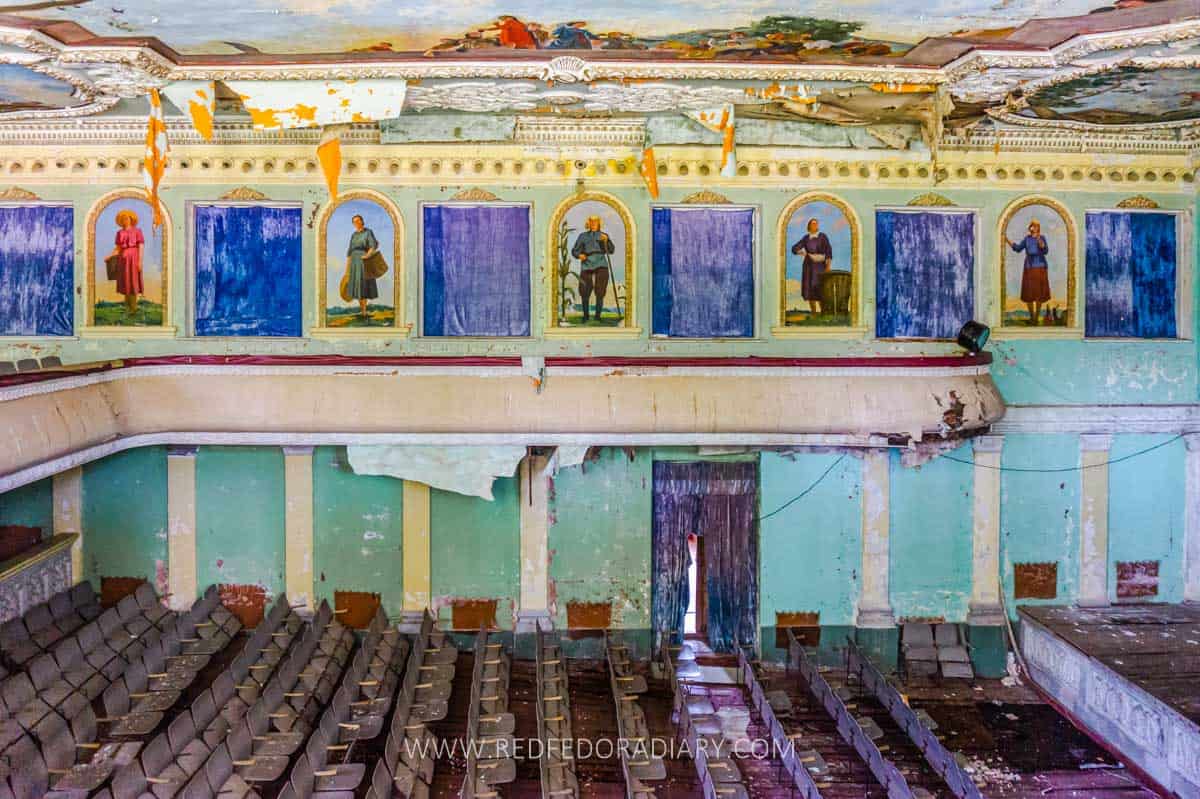
They often showed scientific progress, industry developments, space exploration, Georgian cultural motifs, and optimistic reality, usually featuring workers, farmers, cosmonauts, and abstract patterns.
As elsewhere in the Union, mosaics were mainly used on the facades of industrial enterprises and public buildings. They were also standard in the interiors of conference and concert halls, libraries, and canteens.
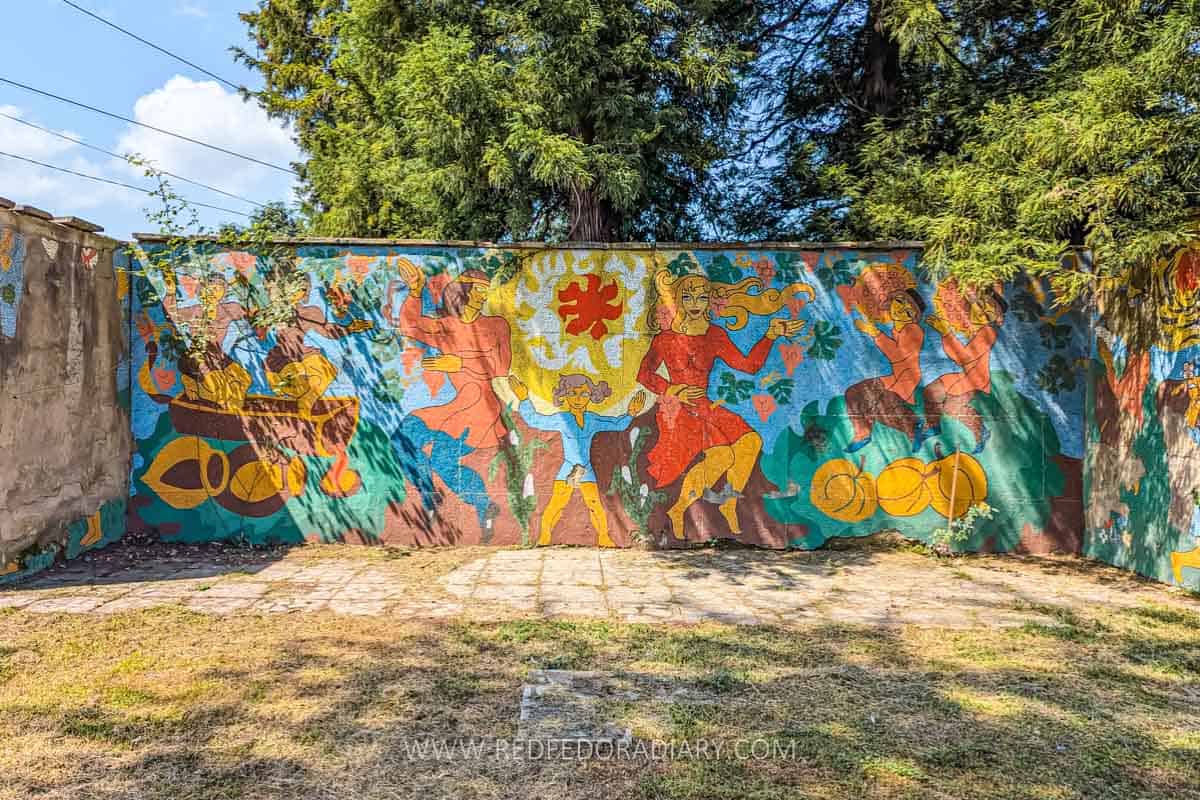
They also stood as independent ornamental fountain pools, wall designs, or bus stops in urban settings. In addition to promoting modern Soviet life, mosaics in Georgia emphasize our traditions and centuries-old heritage.
National costumes such as chokha (high-neck wool coats with rows of felted cases for rifle cartridges) or regional attire, musical instruments such as chonguri (a four-stringed lute), panduri (a three-string plunked instrument), or stviri (a type of flute) are common.
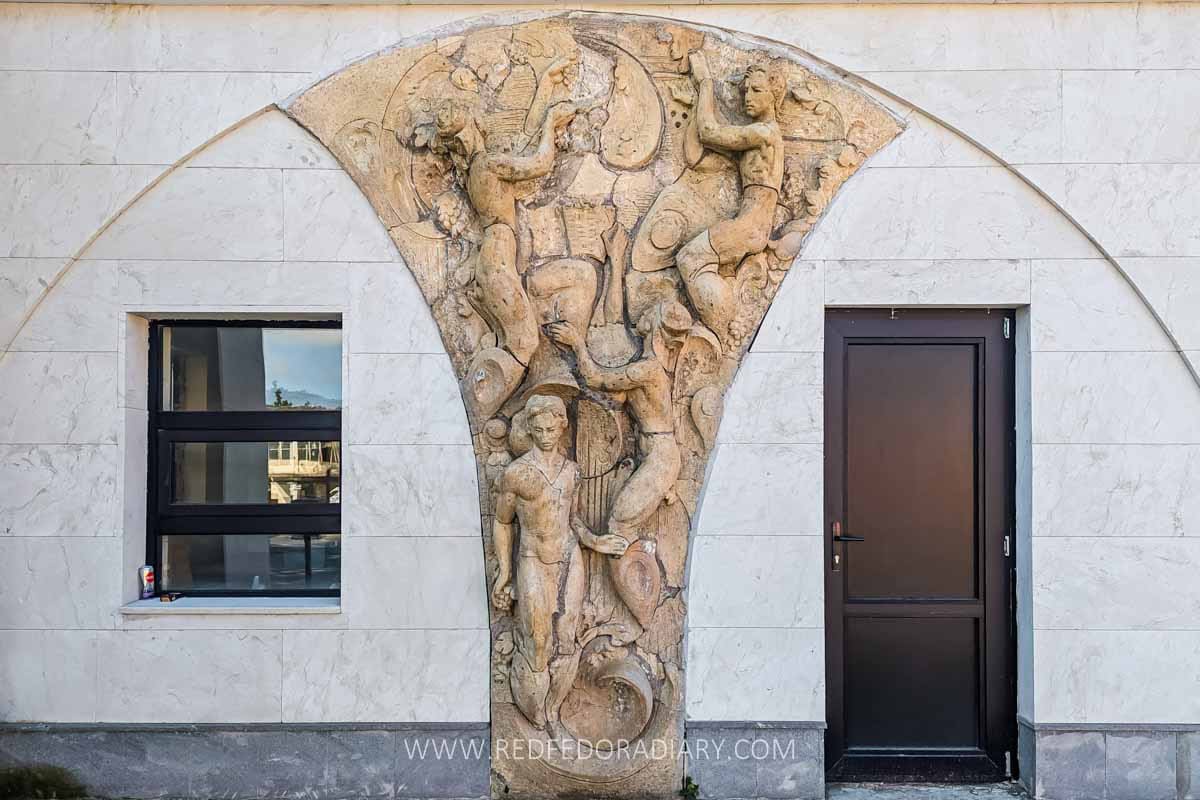
The mosaics also feature dances and mystical or fairytale characters, such as a red deer or Golden Fleece. Women in the mosaics often wear long, colorful dresses, while men wear traditional or regional outfits.
Mosaic-decorated bus stops are common in small towns and villages, especially in Western Georgia’s Guria and Samegrelo regions.
These decorative bus stops mirrored local aesthetics. For instance, in the Black Sea towns, stops emphasized marine life and water sports, while grapes and other local fauna were a focus in the Kakheti wine region.

These stops became experimental canvases for Soviet architects without worrying about the central authorities’ response. Moreover, they served as a “pop of color” and “enjoyment” for locals instead of waiting for the bus in plain construction and seating.
Sometimes, the public spaces or the resort complexes also feature three-dimensional mosaic compositions, such as the so-called “Octopus” cafe in Batumi or an underwater world fountain in Kobuleti (both exmpained below).
Decay after the collapse of the Soviet Union
Sadly, various socio-economic problems that Georgia underwent after the collapse of the Soviet Union in 1991 and that still linger across the country today have entirely neglected public, private, or governmental interest in preserving these buildings, mosaics, and bus reliefs.
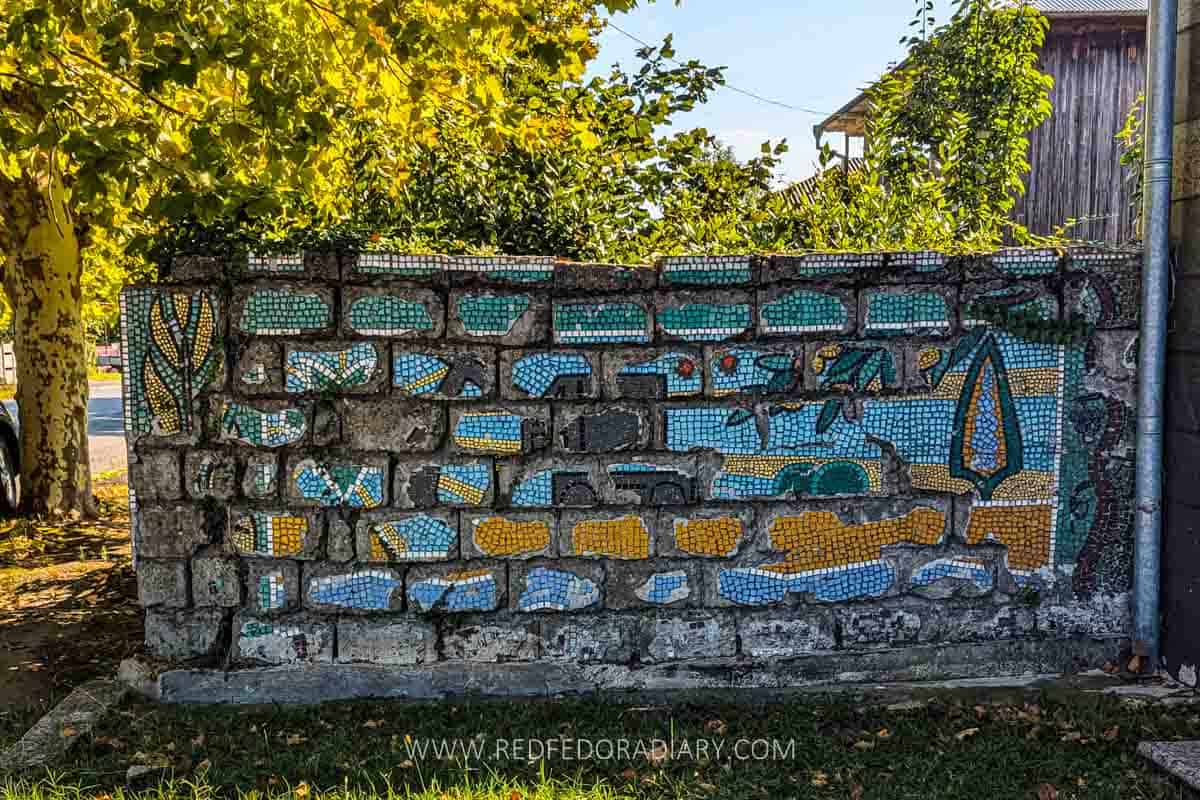
While Georgia tried to get on its feet as an independent nation and struggled with regional and civil wars (in Tbilisi and Abkhazia), it was a time for survival for many who were left without jobs, food, or money.
The whole decade of the ’90s is what locals call “dark 90s,” literally and figuratively. No electricity, no heating, food shortage, and no safety were the prime problems when I was growing up.
Therefore, no one cared about preserving or caring for these buildings or monumental art. Almost all these structures were robbed for whatever was precious.
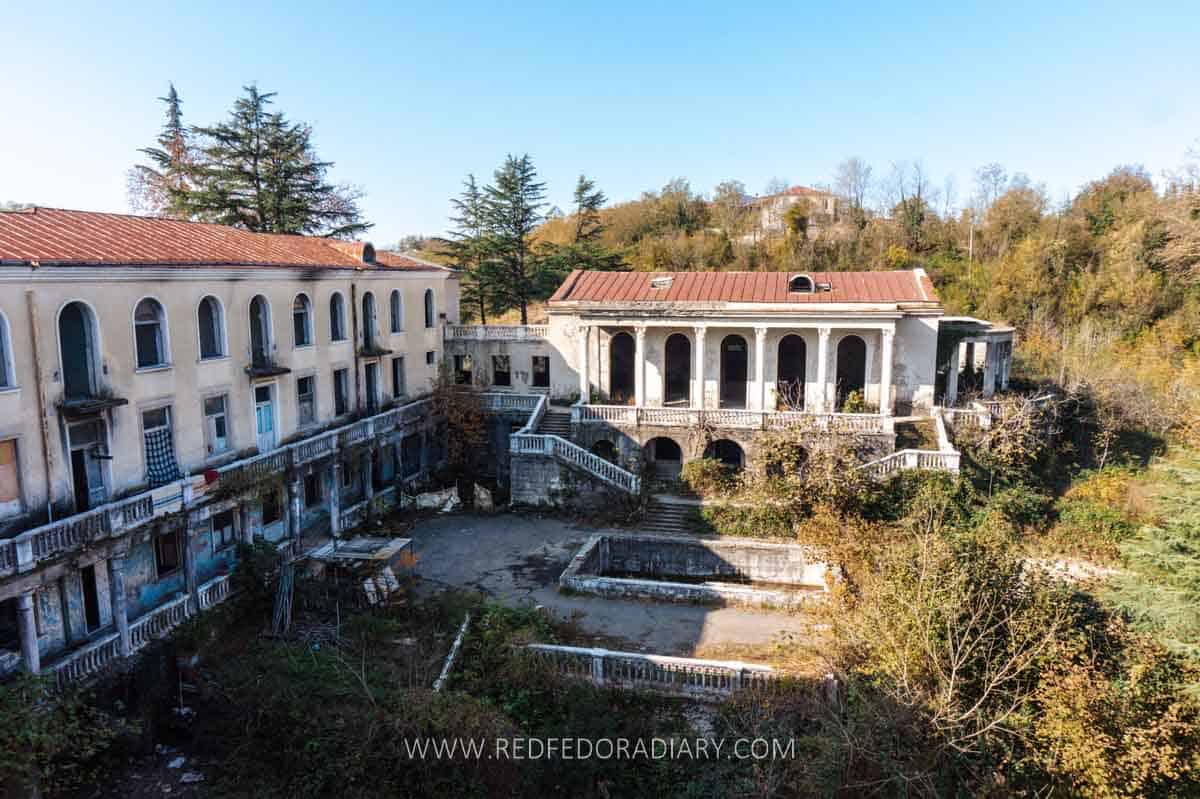
At the same time, parts of the hotels, sanatoriums, or resorts were inhabited by internally displaced persons (IDPs) as the result of the Abkhazia and South Ossetia wars (some still are after over 30 years).
Because of this nationwide neglect and notion that ‘everything Soviet is bad,’ most of these fine examples of Soviet architecture in Georgia will eventually be demolished, privatized without preservation, or collapsed.
However, for the past few years, more public interest has increased in preserving them, especially the mosaics, but it is still a drop in the ocean. Ribirabo Fountaion is the only community I know that works solely on the conservation and reconstruction of Soviet mosaics in Georgia.
The best examples of Soviet architecture in Georgia
Bank of Georgia Headquarters in Tbilisi
The former Ministry of Highway Construction, now home to the Bank of Georgia Headquarters since 2007, remains one of Tbilisi’s most striking examples of Soviet modernist architecture.

Despite privatization, its raw concrete facade, precise geometry, and futuristic aesthetic remain unchanged, solidifying its status as an architectural landmark.
Designed in 1975 by architects Giorgi Chakhava and Zurab Jalaghania, it symbolizes the boldness of Brutalism and is one of the most famous buildings in Georgia and the former Soviet Union.


Often likened to a massive concrete puzzle stacked against the hillside, its design follows the “Space City” or “Horizontal Skyscraper” concept, influenced by the Japanese Metabolist movement.
Rather than a conventional high-rise, the architects envisioned interlocking volumes supported by three core pillars. This approach wasn’t just visually impressive but also preserved the greenery beneath.
The Chronicles of Georgia in Tbilisi
Perched above the Tbilisi Sea, The Chronicles of Georgia is one of the city’s most unique yet often overlooked landmarks. Dubbed the “Georgian Stonehenge,” this towering monument was designed by Zurab Tsereteli in the 1980s, though it was never fully completed.

While not explicitly tied to a specific Soviet architectural style, the monument exemplifies Soviet-era grandeur, blending Georgian history, culture, and national identity into a single structure.
The complex has 16 towering pillars, each standing 30-35 meters high and adorned with intricate bronze reliefs. The upper sections honor Georgian kings, queens, and historical figures, while the lower panels illustrate biblical scenes.
Palace of Rituals or Wedding Palace in Tbilisi
Standing on a hill overlooking the Ortachala neighborhood, the Palace of Rituals is one of Georgia’s most remarkable Soviet-era examples. Commissioned in 1979 and completed in 1985, it was designed by Victor Jorbenadze and Vazha Orbeladze, who took an unconventional, experimental approach to modernist architecture.

Unlike anything else in Tbilisi, the building’s monumental exterior contrasts with a profoundly symbolic interior layout. Jorbenadze, inspired by his mother’s work as a gynecologist, shaped the design to mirror the female reproductive system.
From above, the main entrance represents the birth canal, with two side structures symbolizing ovaries. At the heart of the structure, the ceremonial hall—the “womb”—served as the space where couples were wed, backing the theme of new beginnings.
This fusion of architectural metaphor and function was rare in Soviet-era design, making the Palace of Rituals truly unique. In 2002, oligarch Badri Patarkatsishvili purchased the building and converted it into a private residence, though his family occasionally opens it for public tours.
Further reading: Explore more remarkable Soviet architecture in Tbilisi, including metro stations and the Tbilisi Skybridge, learn about different Soviet-era architectural styles, and view the floor plans of some iconic buildings.
Former cafe Fantasia in Batumi
Designed by architect George Chakhava and mosaic artist Zurab Kapanadze in 1975, this impressive three-dimensional monument, often called the ‘Octopus’ by locals, used to be known as Cafe Fantasia, which opened in the 1980s.
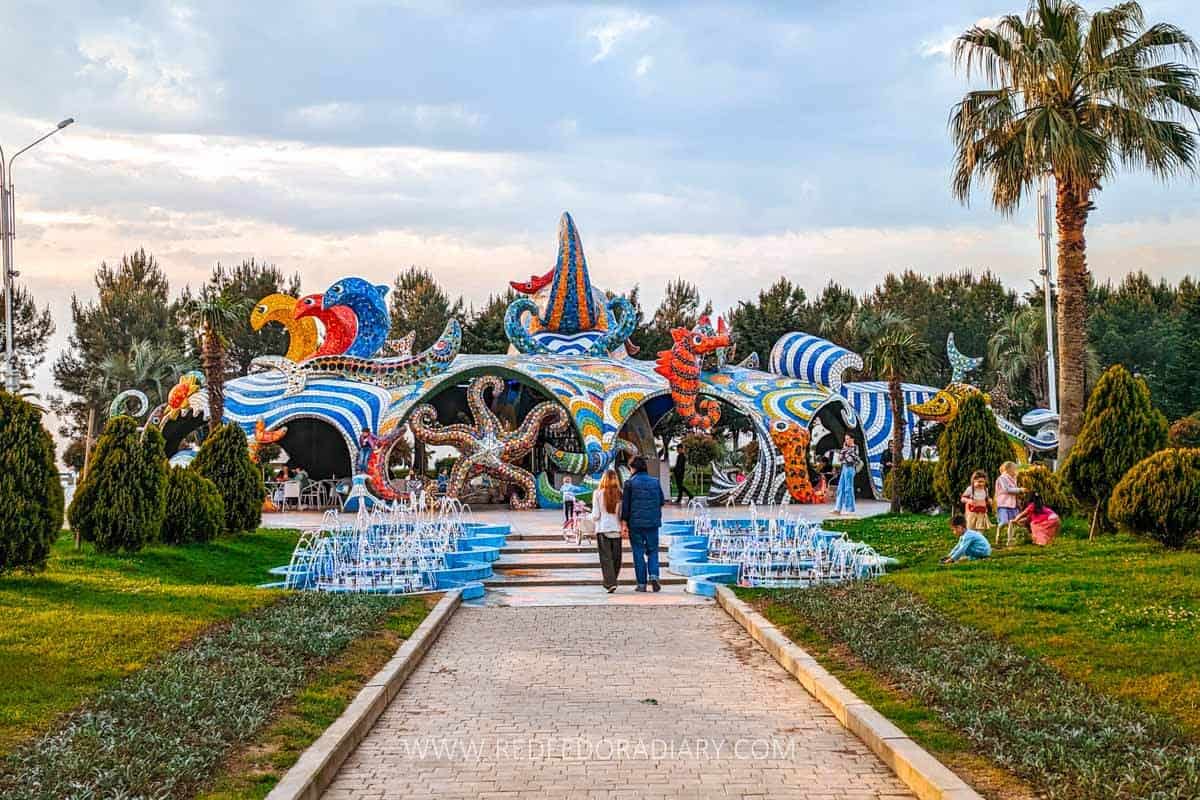
This whimsical and one of my favorite Soviet mosaics in Georgia quickly became popular nationwide and outside the country. Every centimeter is plastered with Smalti tiles, forming an incredibly colorful and vivid masterwork.
Each leg of an octopus supports the base divided by rounded, arched entryways. In addition to the octopus, various other sea animals adorn the layout, from playful dolphins to curling starfish.


Following the collapse of the Soviet Union, it was severely damaged due to neglect and abandonment, but it was restored and reopened in 2019 as a heritage monument.
Further reading: Check out my detailed Batumi city guide to find more Soviet relics and the best things to do in the Black Sea Coast’s capital.
Soviet sanatoriums in Tskaltubo
In the Soviet Union, visiting a sanatorium wasn’t a luxury but a state-mandated necessity. Millions of citizens across the USSR participated in these state-sponsored retreats, where rest and treatments were essential for maintaining a productive workforce.
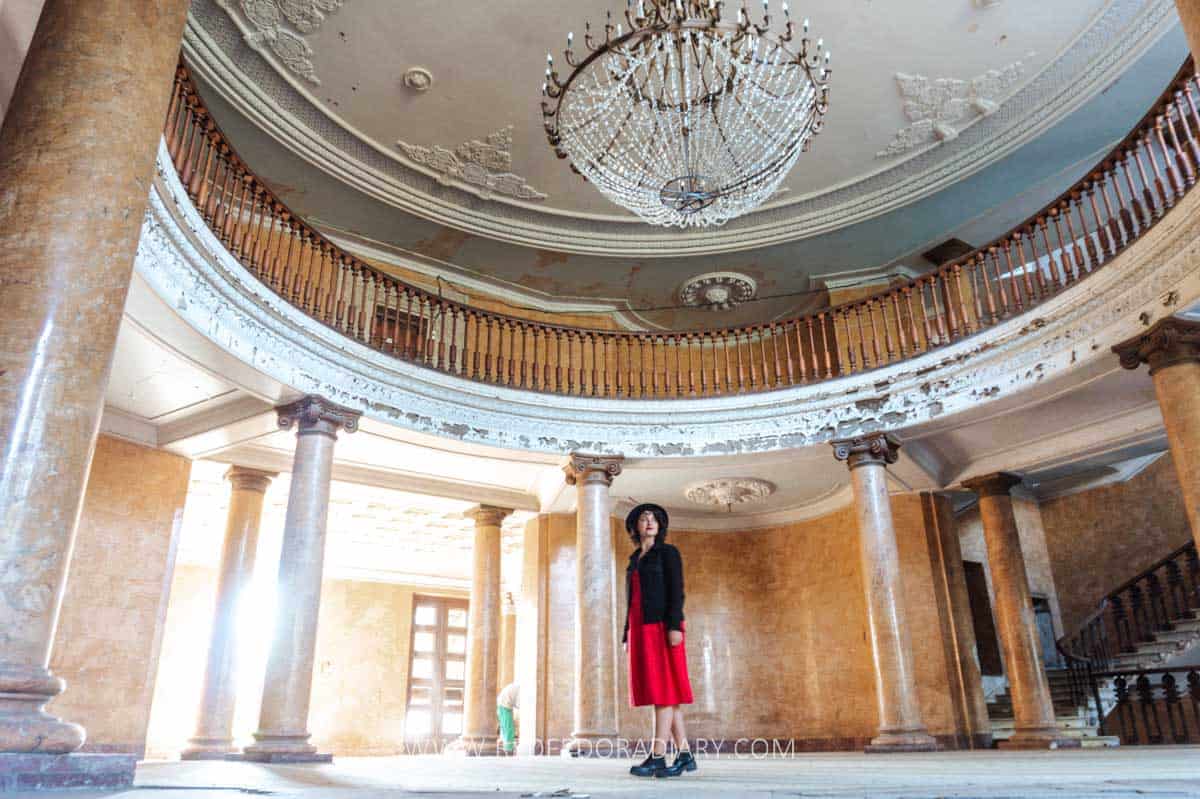
In 1950, Soviet architects designed an ambitious plan for Tskaltubo, a small town near Kutaisi. The plan envisioned a spa town with 19 sanatoriums and nine bathhouses arranged around a central park.
Construction moved incredibly fast, with over 4,000 workers working nearly nonstop. Within a year, the first bathhouse opened its doors, marking the beginning of Tskaltubo’s rise as the Soviet Union’s premier wellness destination.
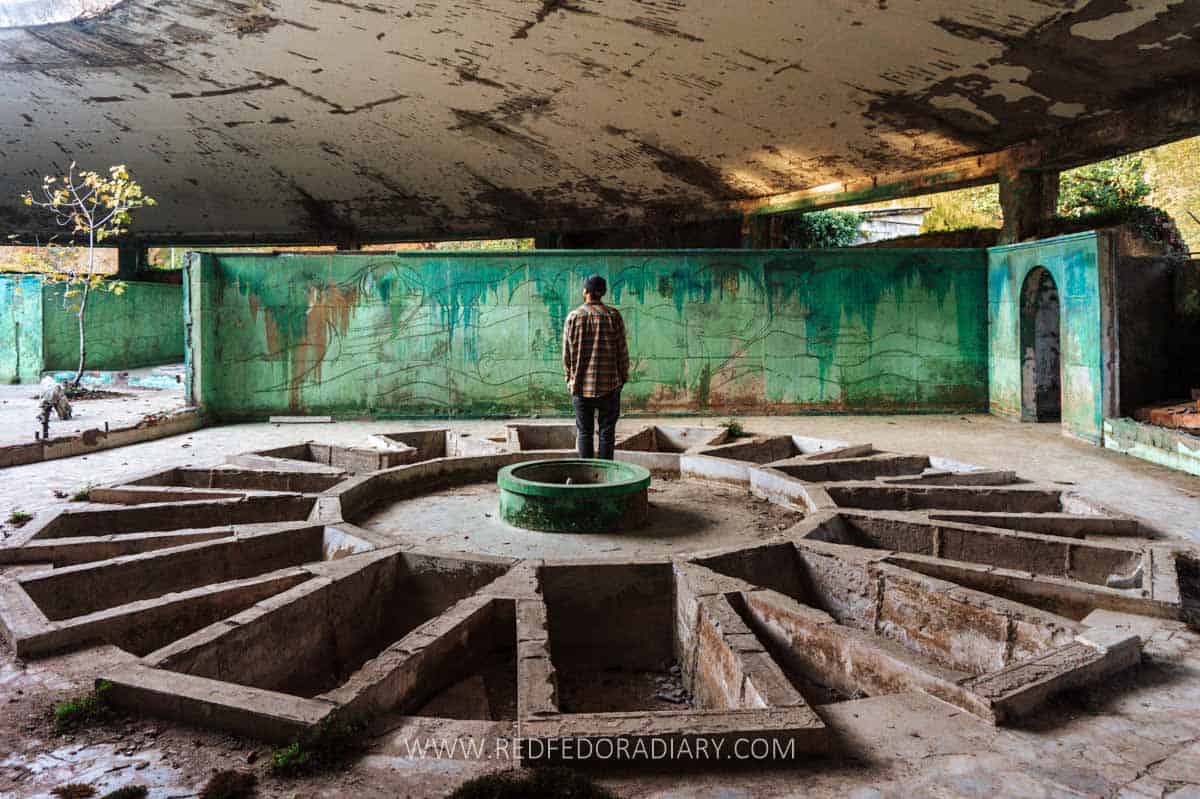
Under the USSR’s “right to rest” policy, thousands arrived daily, including four trains packed with visitors from Moscow (the distance between those two towns is 1,963 km). Even Joseph Stalin allegedly had a summer residence nearby.
Unlike the stereotypical image of Soviet architecture as plain and functional, many of these sanatoriums were grand, with neoclassical facades, intricate detailing, and lavish interiors, making them prime examples of Stalinist architecture in Georgia.
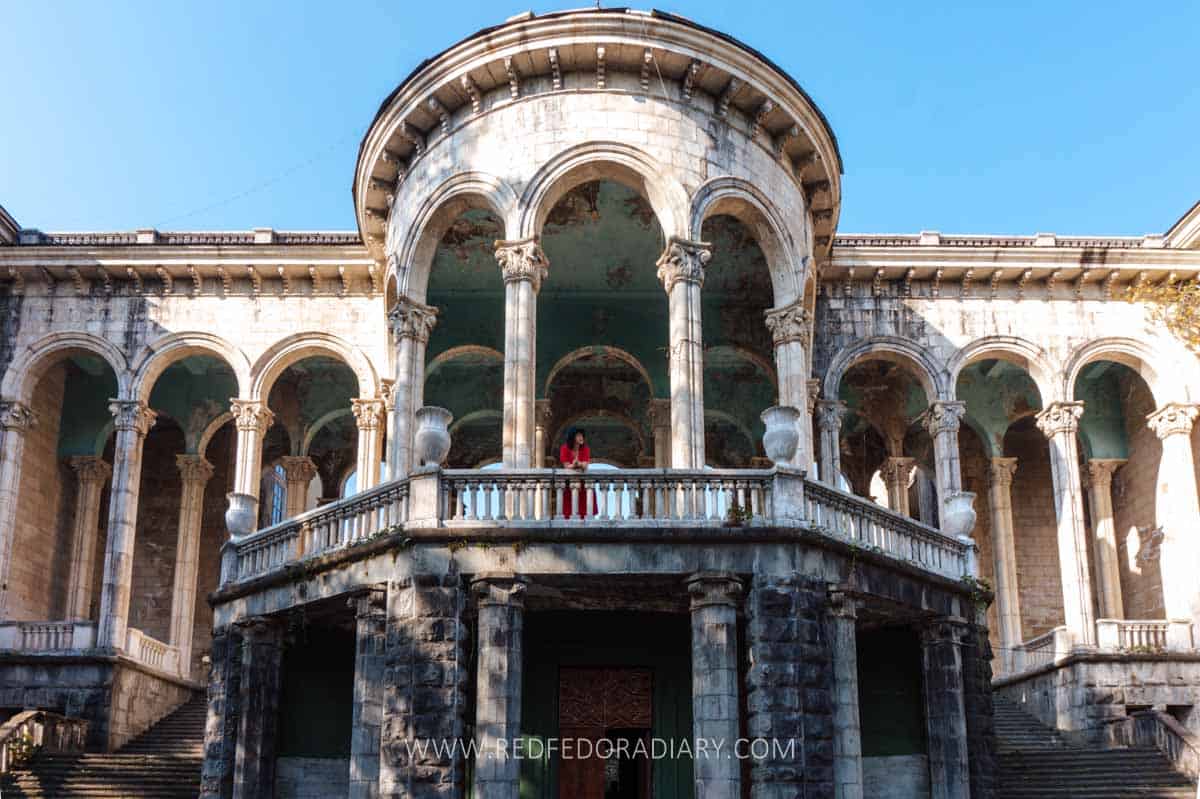
Today, some of these grandiose buildings are abandoned and in disrepair, while others have been privatized, with plans to revive Tskaltubo as a spa destination.
Further reading: My detailed guide to Tskaltubo Santoriums includes a map of the most iconic places to visit and delves deep into its history and construction.
Georgia-Russia Friendship Monument in Gudauri
Situated along the Georgian Military Highway, this monument was built in 1983 to mark the 200th anniversary of the Treaty of Georgievsk, which placed eastern Georgia under Russian protection.
As a side note, Russia broke the terms of the treaty in a few years and officially annexed Georgia in 1801.
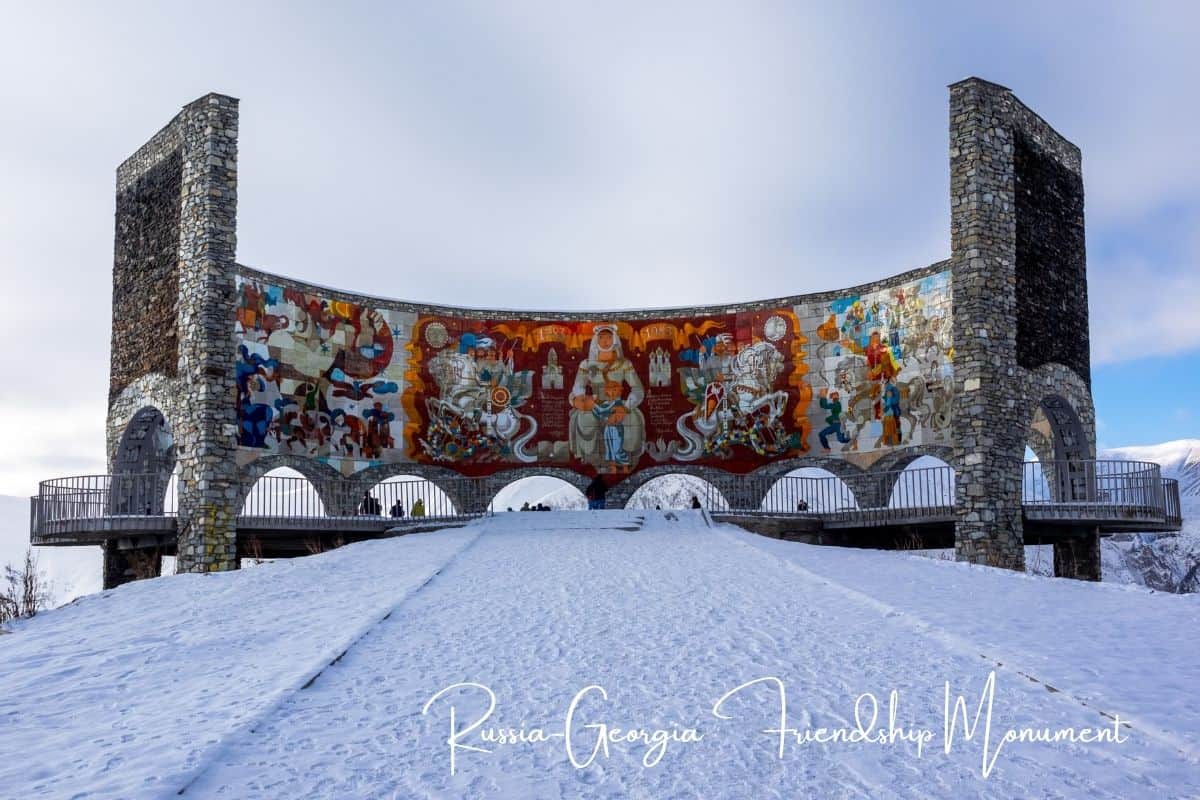
Therefore, Georgians strongly resisted the celebration. Ironically, Moscow disliked the monument and disapproved of its artistic interpretation of Georgian-Russian friendship.
Despite its controversial origins, the monument is now one of the most famous Soviet structures in Georgia and a popular photo spot when traveling from Tbilisi to Kazbegi.
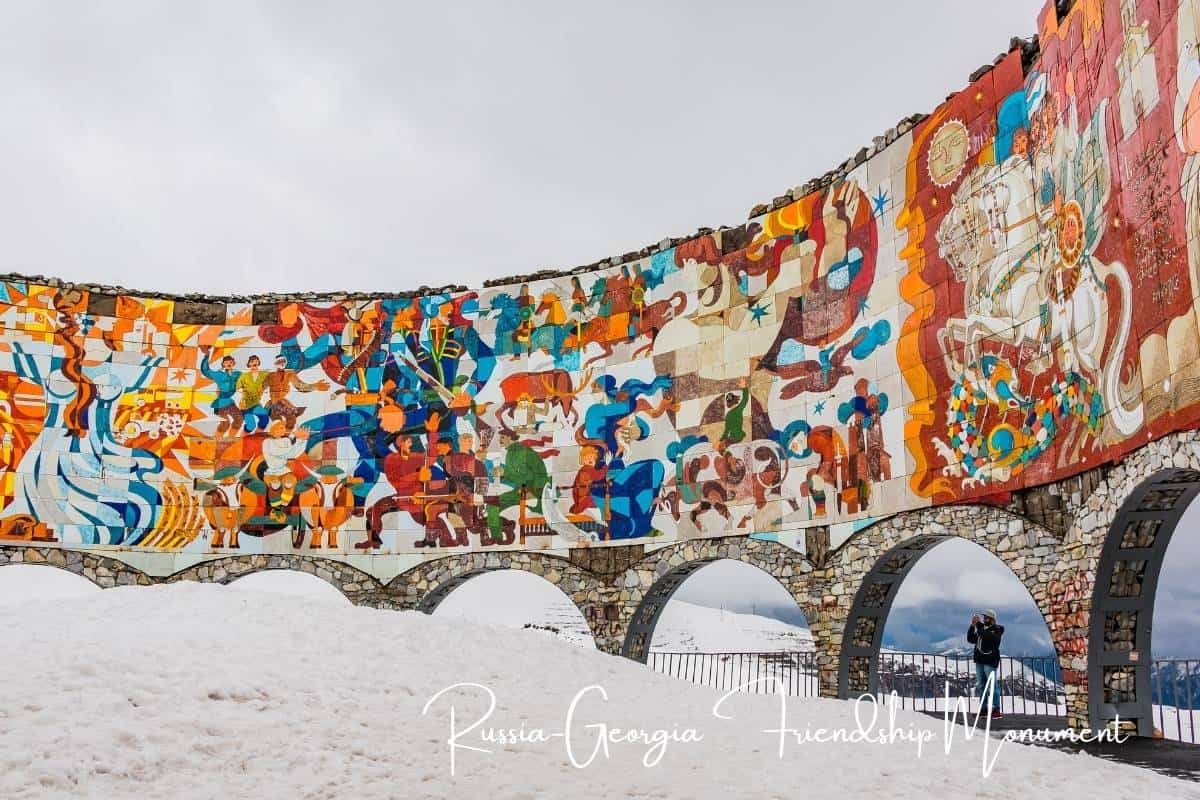
It also holds significance as the first large-scale work to incorporate the cloisonné technique—traditionally used in enamel jewelry—into a monumental structure.
By separating colors with partitions and using an innovative material, they created a vibrant, multicolored composition rather than the usual monochrome.
Cable cars in Chiatura
Chiatura’s cable cars, often called the “Metal Coffins,” are among the most impressive leftovers of Soviet architecture in Georgia.
Built in 1954, they were the first aerial transport system in the Soviet Union, designed to make commuting easier for manganese miners working in the steep, rocky terrain of Chiatura.

At its peak, the system had around 17 lines, connecting different parts of the town with the mines and residential areas. Most of the cabins were small, boxy, and suspended by thick steel cables, giving them a spooky appearance.
Over the decades, maintenance issues and safety concerns led to the gradual closure of most lines, but locals still used a few until the early 2020s.
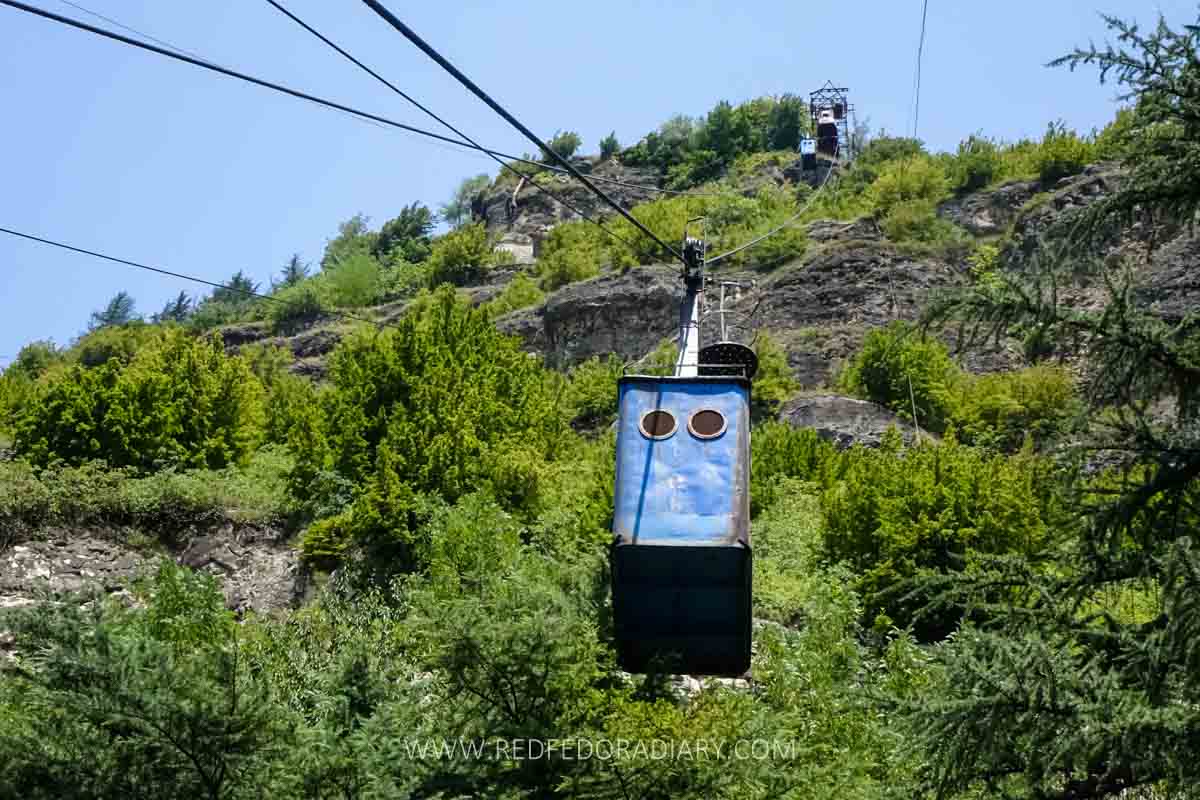
In recent years, a new, modern cable car system has been introduced, replacing some of the original Soviet-era cabins and renovating a few old ones.
The old stations and disused lines remain integral to Chiatura’s industrial past, drawing urban explorers and tourists who want to experience the eerie Soviet infrastructure.
Big Shiraki abandoned airfield in Kakheti
Big Shiraki Airfield is an abandoned Soviet military airstrip in the vast, open plains of the Kakheti region, making it a lesser-known and unforgettable place in Georgia. Today, it is a haunting relic of the USSR’s military ambitions, slowly reclaimed by nature.
The airfield, built in the 1950s, was used to train Soviet pilots to fly MiG aircraft. Its remote location in the Shiraki Plateau—far from major cities—made it an ideal site for military exercises.
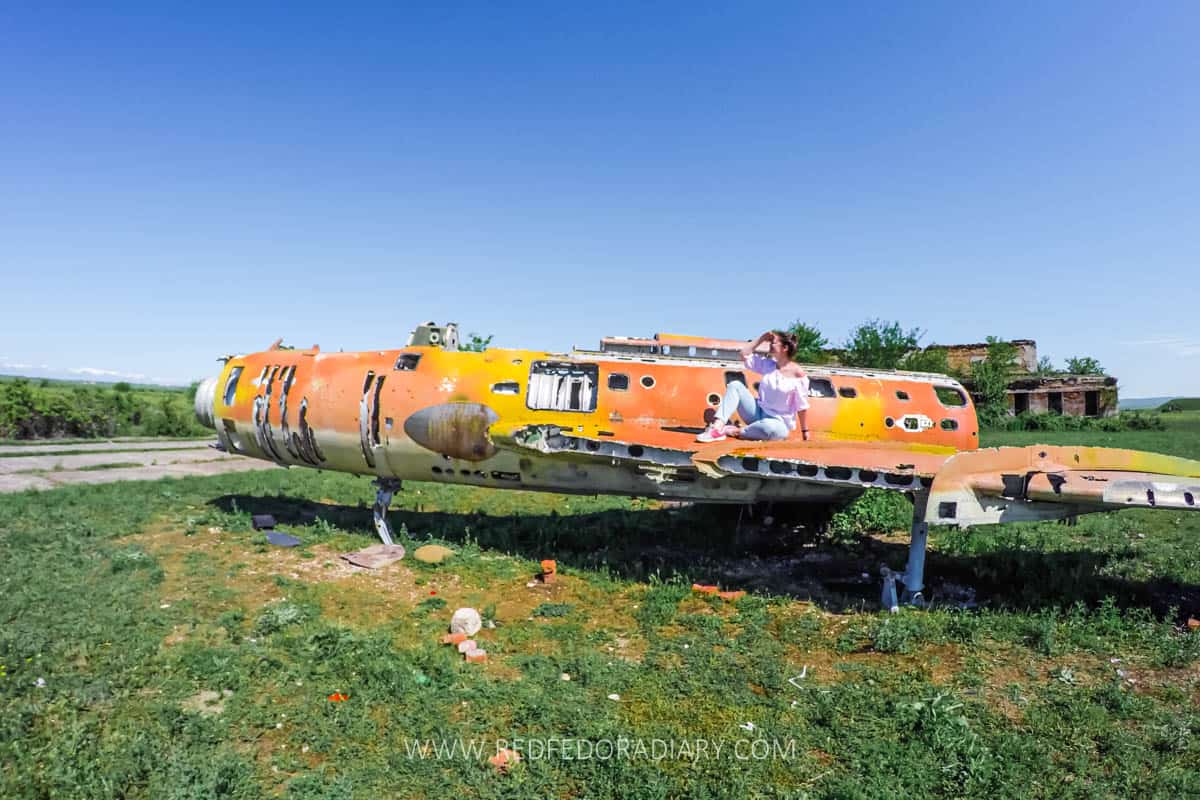
The airstrip is surprisingly well-preserved, with its long concrete runway still visible, though cracks and overgrown vegetation suggest decades of neglect.
One of the most unique scenes of Big Shiraki Airfield is the row of abandoned hangers designed to blend with the landscape perfectly. They look like small hills and seem almost hidden as you approach the airfield. They are barely visible from the above, either.
However, the most remarkable item is the rusted infighter jet standing silently on the massive steppe. Although most of its parts are gone, it still looks pretty cool!
Visiting Big Shiraki is possible as a long day trip from Tbilisi with a car – no public transport is available. The journey requires 2:30-3 hours one way, but it’s an adventure on its own. Use LocalRent if you decide to drive yourself or a return GoTrip for a private transfer at a reasonable price.
Alternatively, you can break up the trip and add Telavi or Sighnaghi to your overnight trip.
Former sanatorium Mountain Valley in Likani
The small town of Likani near Borjomi was one of the spa towns in Soviet Georgia, full of resorts and sanatoriums. Much like Tskaltubo, most of these buildings were inhabited by internally displaced persons (IDPs) from the Abkhazia and South Ossetia conflicts in the late 1980s and early 1990s.

Constructed in the 1970s and partly abandoned and changed, it features remarkably well-preserved monumental art that easily ranks as one of my top favorite Soviet mosaics in Georgia.
This incredibly colorful mosaic has everything from grape vines to winemaking, Georgian mountains to various flora and fauna, agricultural and industry development, and cultural motifs.
Further reading: My Borjomi city guide focuses on the best things and attractions to enjoy in another Georgian spa town.
Kolkhida Monument in Kutaisi
Kolkhida, another special Soviet-era bas-relief, is hard to miss at the main entrance of Kutaisi’s famous Green Market.

The artwork pays homage to Colchis (Kolkheti in Georgian), an ancient region along the Black Sea dating back to the 17th century BCE. Famous for its connection to the myth of the Argonauts, Colchis is often considered a foundation of Georgian history and culture.
Georgian artist Bernard Nebieridze created the bas-relief between 1980 and 1985. It was installed on the market’s exterior in 1995, years after the artist died in 1987.
With its distinct rust-orange hue, the piece intricately depicts scenes from the Colchis Kingdom, including Medea, the Argonauts, and the legendary Golden Fleece.
Labor monument in Kutaisi
Glory to Labor Monument, dedicated to Socialist labor heroes from Kutaisi, is a 1980 Soviet-style sculpture created by I. Bastanashvili and E. Amashukeli.


The monument features various statues made from wrought iron, representing different agricultural fields and seasons.
Further reading: Check out my Kutaisi city guide for more interesting things to do in one of my favorite cities in Georgia after Tbilisi.
Didgori Battle Memorial (Mtskheta-Mtianeti region)
Even though the Didgori Battle Monument was erected in 1990, right before the Soviet Union collapsed, it remains a fascinating example of Soviet monumental art in Georgia.
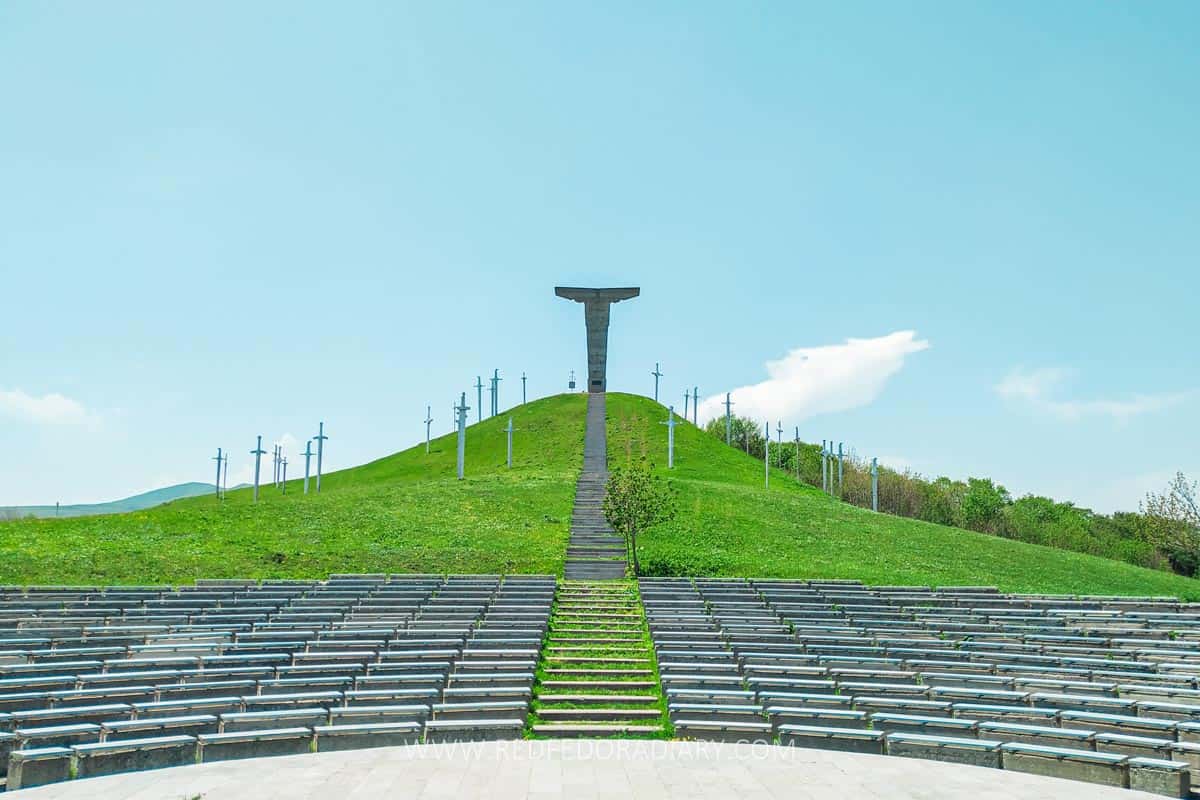
Perched atop the Didgori Pass, about 40 kilometers from Tbilisi in the Mtskheta-Mtianeti region, this monument commemorates the pivotal Battle of Didgori in 1121.
In this battle, King David IV of Georgia (David the Builder) led his forces to a decisive victory over the Seljuks (Turco-Persian, Sunni Muslim empire), marking the beginning of Georgia’s medieval golden age.
I absolutely love the towering metal swords planted into the ground, which evoke a feeling of a battlefield frozen in time. They also look like massive crosses, symbolizing both the victory and the sacrifices of Georgian warriors.

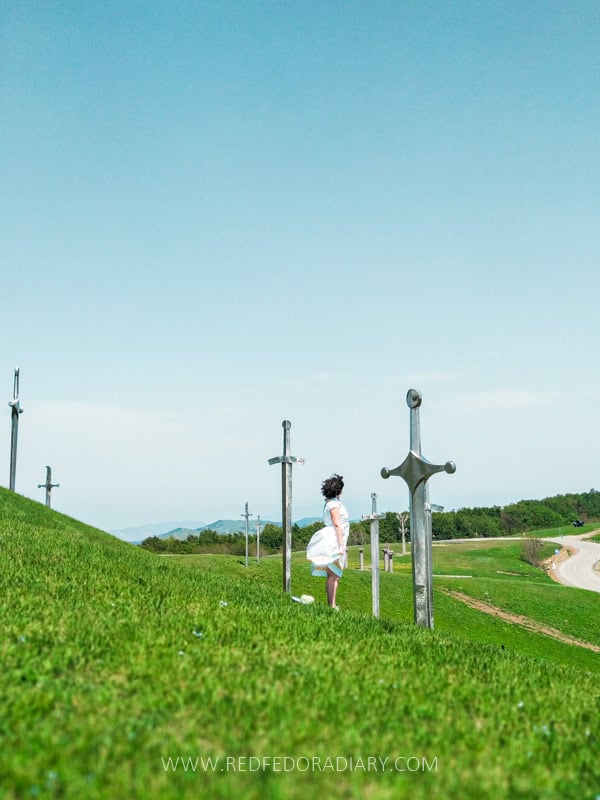
The layout is stark yet powerful. Beyond its historical and architectural importance, the monument offers breathtaking panoramic views of rolling hills and mountain ridges.
Visiting the site is an easy day trip from Tbilisi. As there is no public transport, it is best accessed by car. Rent a car with LocalRent or use a GoTrip transfer.
The Administrative Building for Collective Farming in Shroma (Guria)
The village of Shroma in the western region of Guria primarily grew tea in the Soviet era; by 1927, the plantations amounted to 100 hectares, and in 1935, to 1,000 hectares.
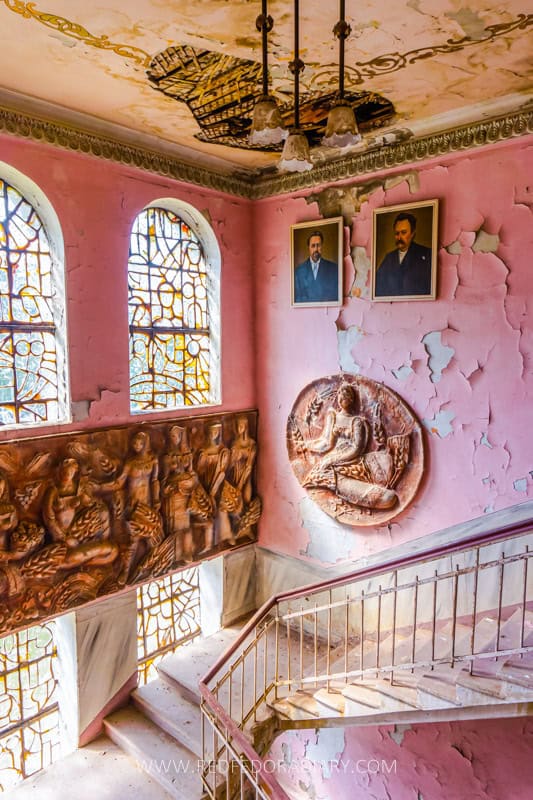
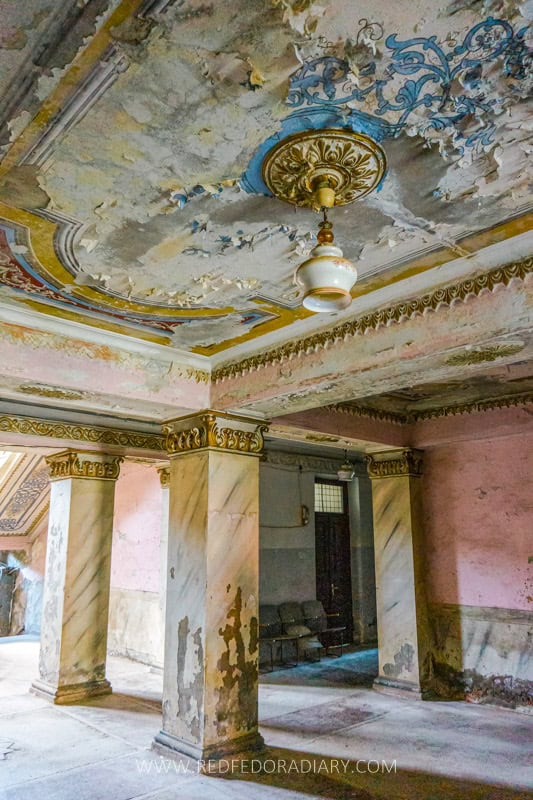
The Administrative Building, built in 1956, has hallways adorned with intricate embellishments, friezes, glass mosaics, bas-reliefs, and ceiling decorations.
However, when we visited a few years back, the building was in pretty bad shape, and I haven’t heard of any restoration work happening for this one yet.
Culture House in Shroma (Guria)
This gorgeous Culture House in Shroma was built in the 1950s and could accommodate 800 people.
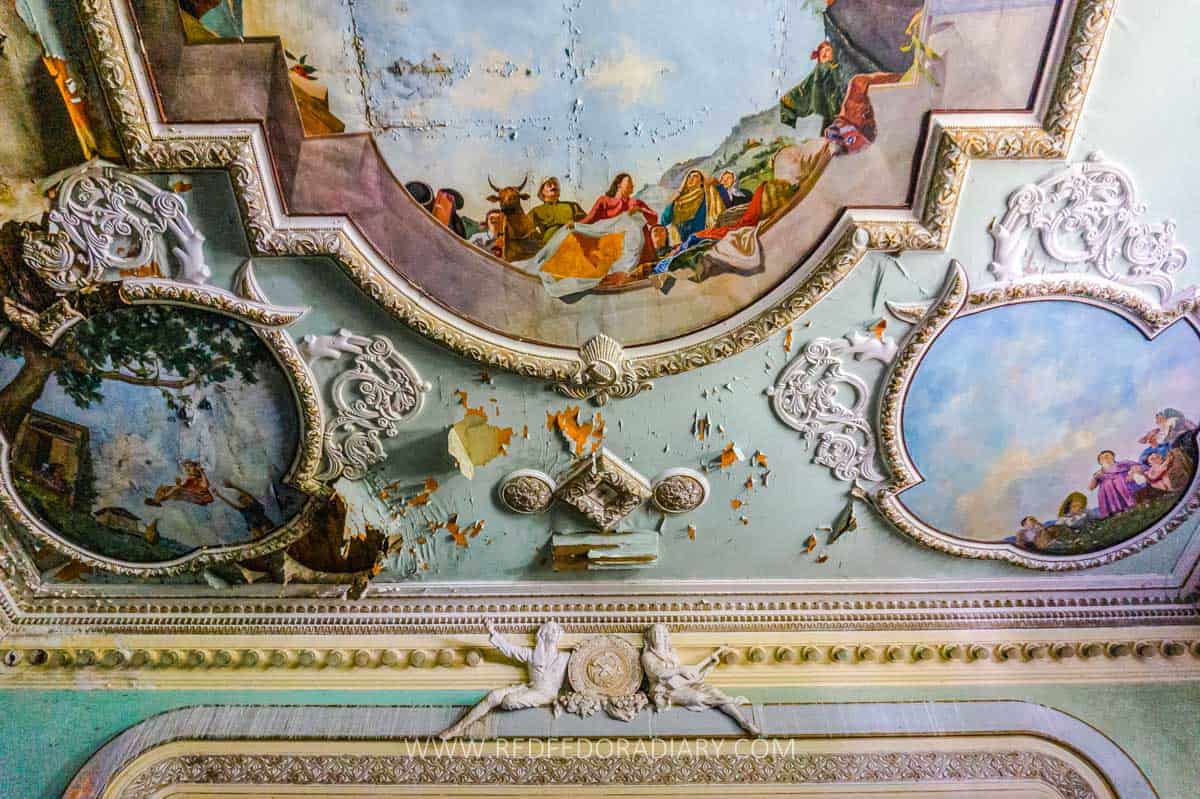
Shroma was one of the wealthiest villages in Ozurgeti during the Soviet era, which obviously resulted in its lavish Soviet architecture. The incredible interior decoration features Gurians in traditional clothes and prime agricultural fields.
The Culture House is currently under construction and will soon have a fresh look. I can’t wait to go back and check it out!
The Administrative Building of Collective Farming in Natanebi (Guria)
Along with Shroma, Natanebi was another of the wealthiest villages in Ozurgeti. Its Lenin Collective Farm owned 382 hectares of tea, 380 hectares of corn, and 115 hectares of citrus plantations.
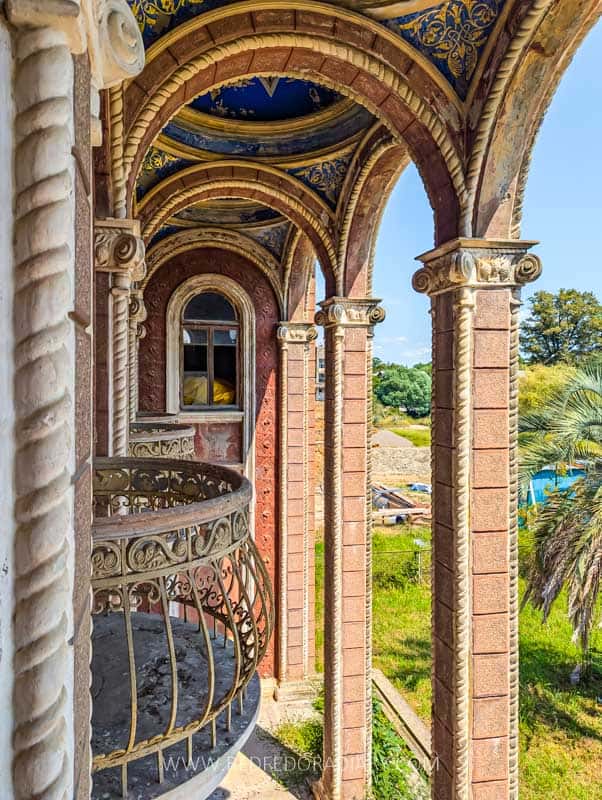

The village also had a Culture House, a hospital, a citrus packing factory, a tea processing factory, several schools, a candlenut drying facility, and a library.
The administrative building, built in 1953, is imposing with its high-rise arcade, intricate balconies, and Soviet symbolism in blue-gold color domes.
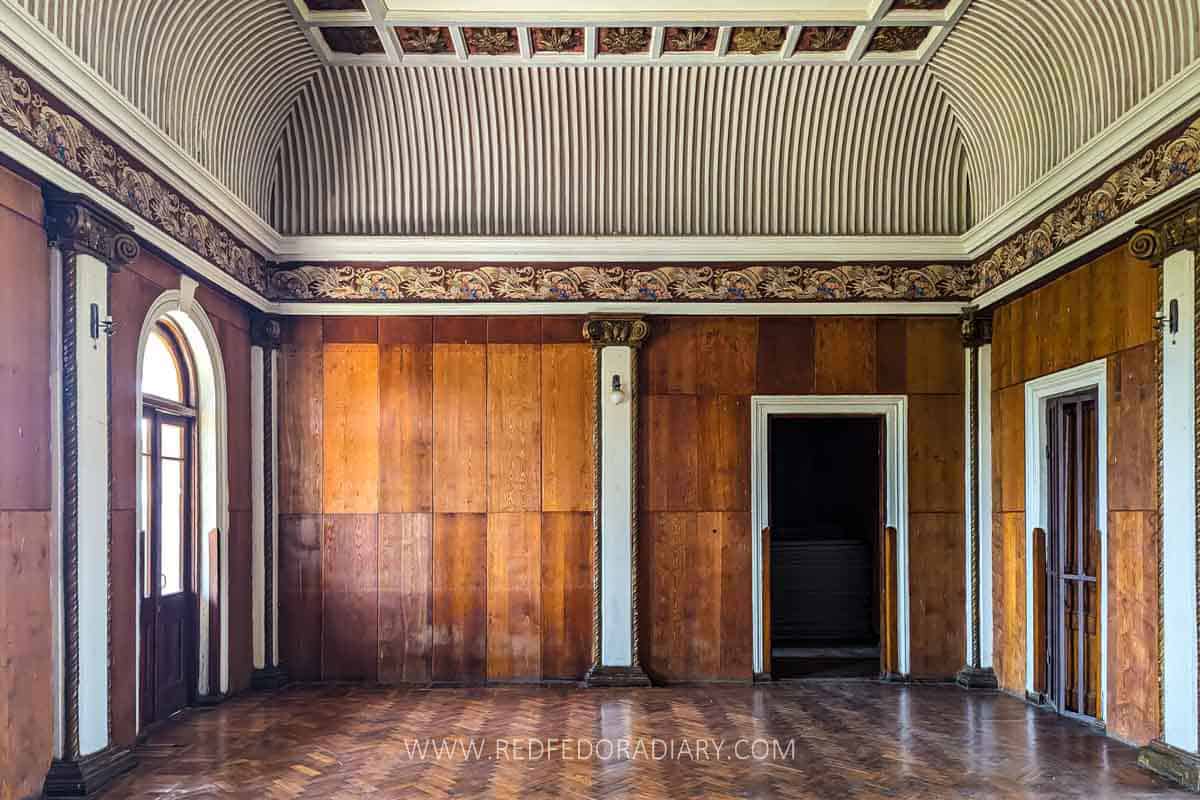
At the entrance hallway, you’ll see the World War II memorial, which honors the heroes with black-and-white pictures, presumably of the village residents who fought in the war.
The remaining building rooms (at least those open) are abandoned and ruined.
Kindergarten in Natanebi (Guria)
The kindergarten building is a few meters from the Administrative Building of Collective Farming.
The mosaic decoration covering a giant wall done in the late 1980s is almost gone, but to my surprise, one of the rooms inside has a well-preserved mosaic of an underwater world from floor to ceiling, a stained glass wall, two pools, and a hanging ship!
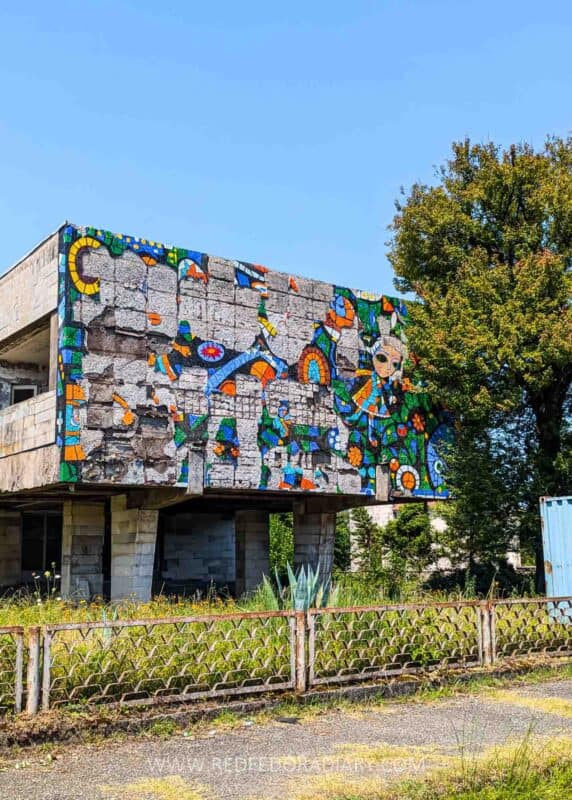
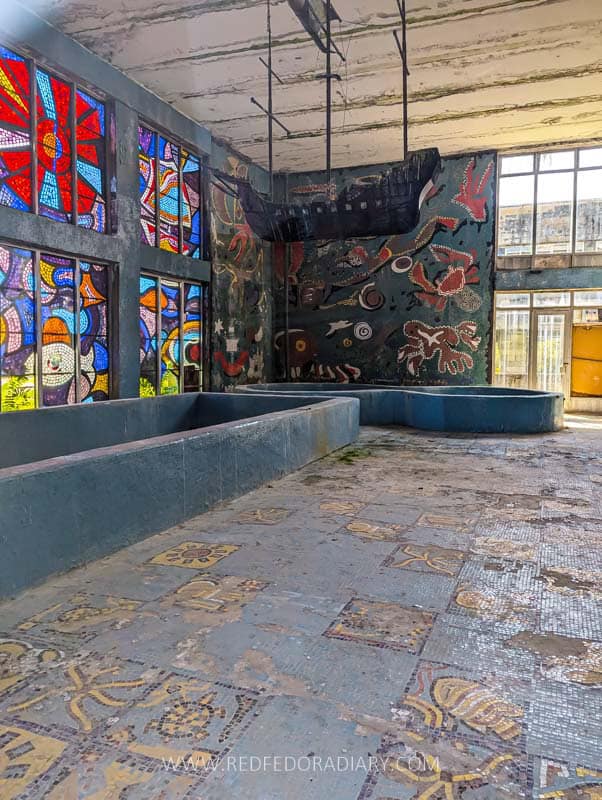
I don’t know if the kindergarten is active. It looked abandoned because of the highly overgrown and low-maintained grass in its courtyard.
We didn’t get to go inside as everything was locked, and I took the pictures through a glass door.
Bus stop in Gurianta (Guria)
This mosaic-adorning bus stop on the highway of Gurianta village is one of my favorite mosaic bus stops in Georgia.

The mosaic has a tea-plantation theme because Guria was one of the country’s prime tea-growing regions. Unfortunately, I couldn’t find any information on the author or the date.
Further reading: Dive into my Ozurgeti guide for a deeper look at what makes this city special, or read my complete Guria guide, which covers the top attractions and unique experiences of the entire region.
Former Ferroalloy Plant in Zestaponi (Imereti)
One of three mosaics in Zestaponi, restored by the Ribirabo Foundation, is at the entrance of a factory owned by Georgian Manganese. It used to be a decorative wall of the former Ferroalloy Plant nearby.
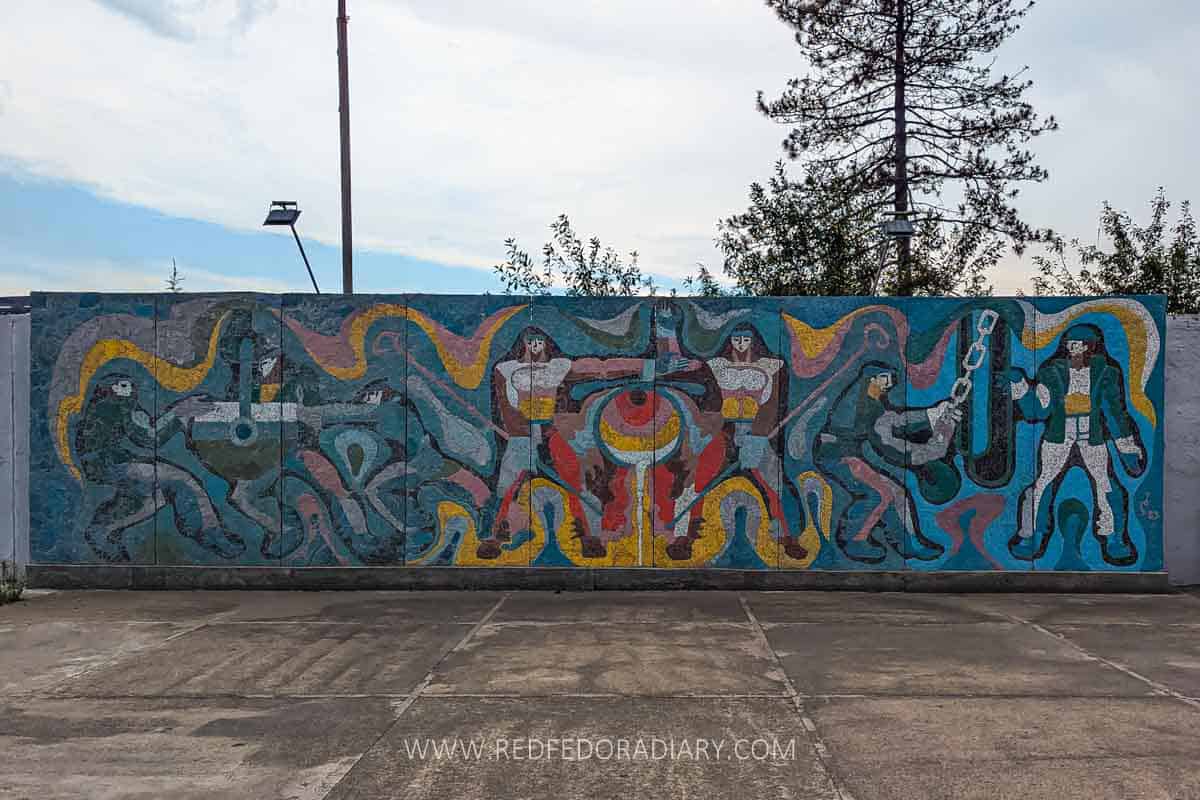
Created by Demur Basheleishvili in 1983, the mosaic was moved from its original location at Giorgi Nikoladze Square on the old Zestaponi-Kutaisi Highway for conservation and preservation purposes.
Bus stop in Sajavakho (Imereti-Guria border)
This bus stop on the road of Sajavakho village, on the border of Imereti and Guria regions, has mosaics on all sides, including inside and outside.
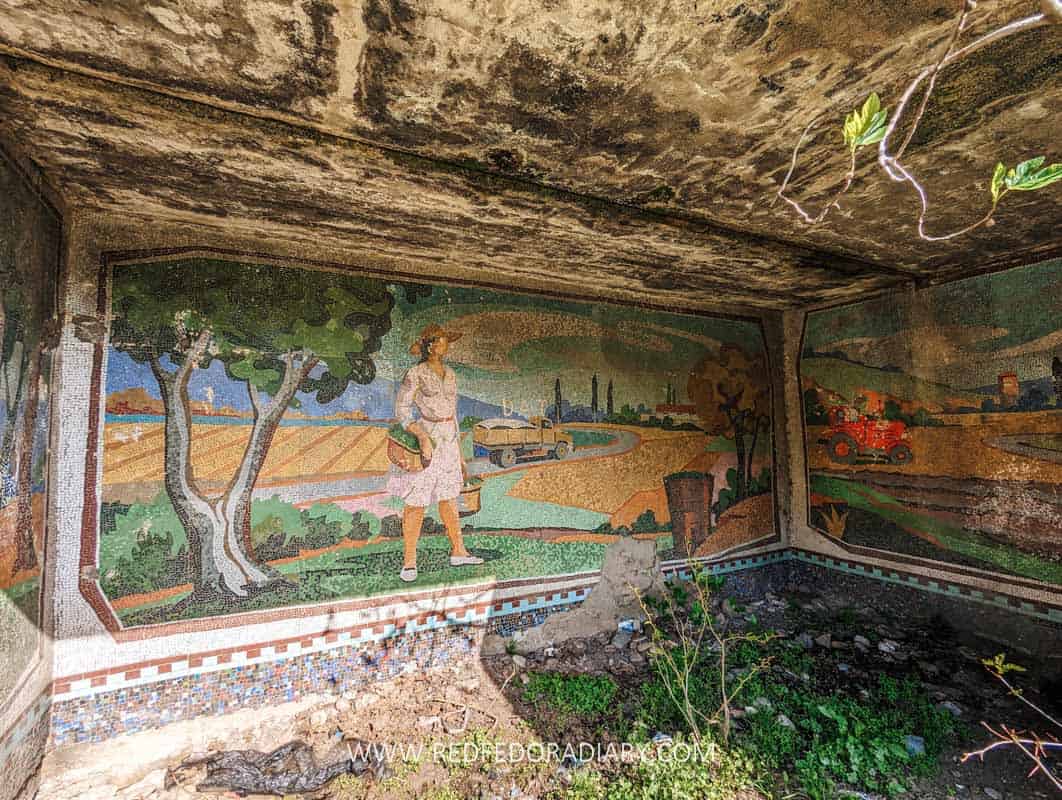
Despite its current condition, where some parts of the mosaics are missing, it definitely ranks as one of my favorite mosaic bus stops, along with the Gurianta one mentioned above.
It mainly shows various agricultural scenes, such as grain fields, citrus, and pumpkin picking. Like many Soviet mosaics in Tbilisi and Georgia, the date and the author are unknown.
Enguri Dam in Samegrelo
The Enguri Dam, one of Georgia’s most impressive engineering accomplishments, is a massive concrete arch dam in the Samegrelo region. It is a must-do stopover on the way to Mestia, Svaneti.

Completed in 1987 after nearly two decades of construction, the Enguri Hydroelectric Power Plant (HPP) is a staggering 271.5 meters high, making it one of the tallest dams in the world. It is crucial in Georgia’s energy sector, generating around 40% of its electricity.
The dam uses the power of the Enguri River, a fast-flowing mountain river flowing from the Greater Caucasus. Its reservoir, surrounded by dramatic cliffs and lush green valleys, stretches over 20 kilometers.
Enguri Dam is an industrial landmark and an emerging tourist attraction. Visitors can take guided tours inside the dam’s massive concrete structure and learn about its construction and importance. Enquire about the tours on this Facebook page.
Monument in Abasha (Samegrelo)
Right in the center of the sleepy town of Abasha in the Samegrelo region, you’ll find another impressive monument showcasing various cultural, ideological, and religious scenes.
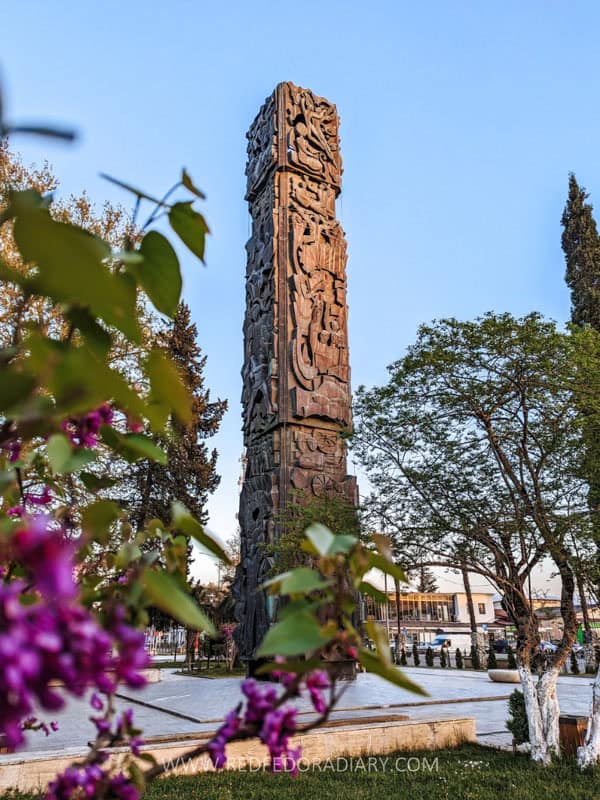
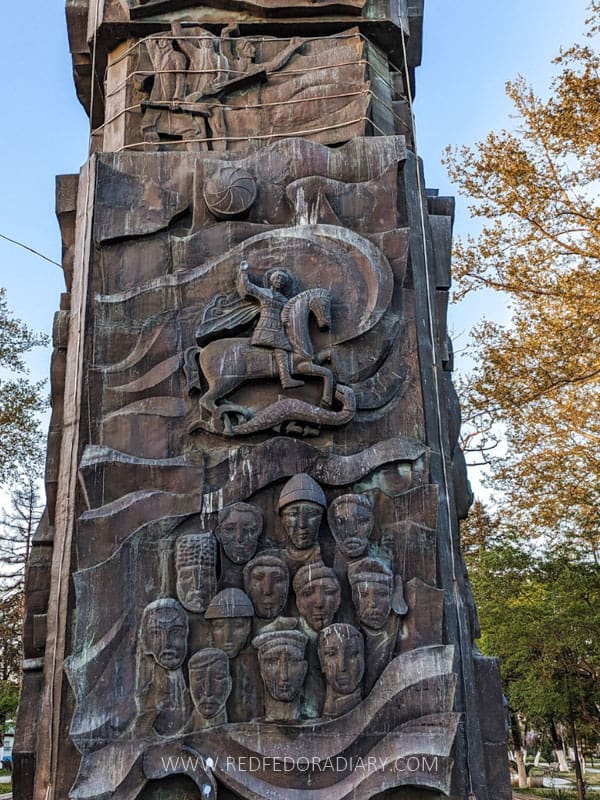
Unfortunately, neither the Soviet-era encyclopedia nor the Architecture of Soviet Georgia book helped me find the author, date, or any relevant information.
Mosaic in Abasha (Samegrelo)
A block away from the monument, you’ll notice a beautiful mosaic created by Vakhtang Nodia, but the date is unknown.
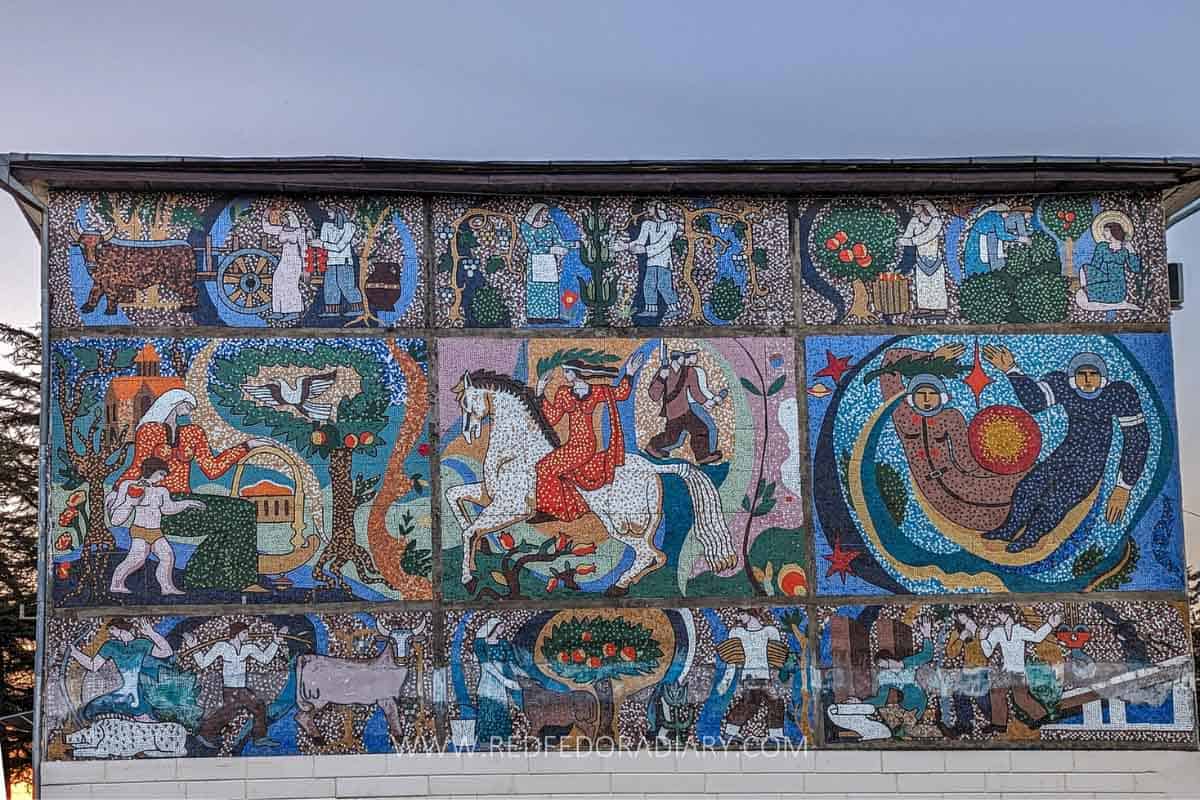
It has nine sections showcasing scenes from agriculture to everyday life, culture, and journeys through the cosmos.
Further reading: Get inspired for your trip through my Samegrelo guide, packed with ideas on what to see and do in the region
Mosaic in Chaisubani (Guria)
Sadly, Chokhatauri Municipality doesn’t have as many Soviet mosaics as its neighbor Ozurgeti does. However, this remarkably well-preserved mosaic on the former Culture House building in Chaisubani village deserves a spot in this post.
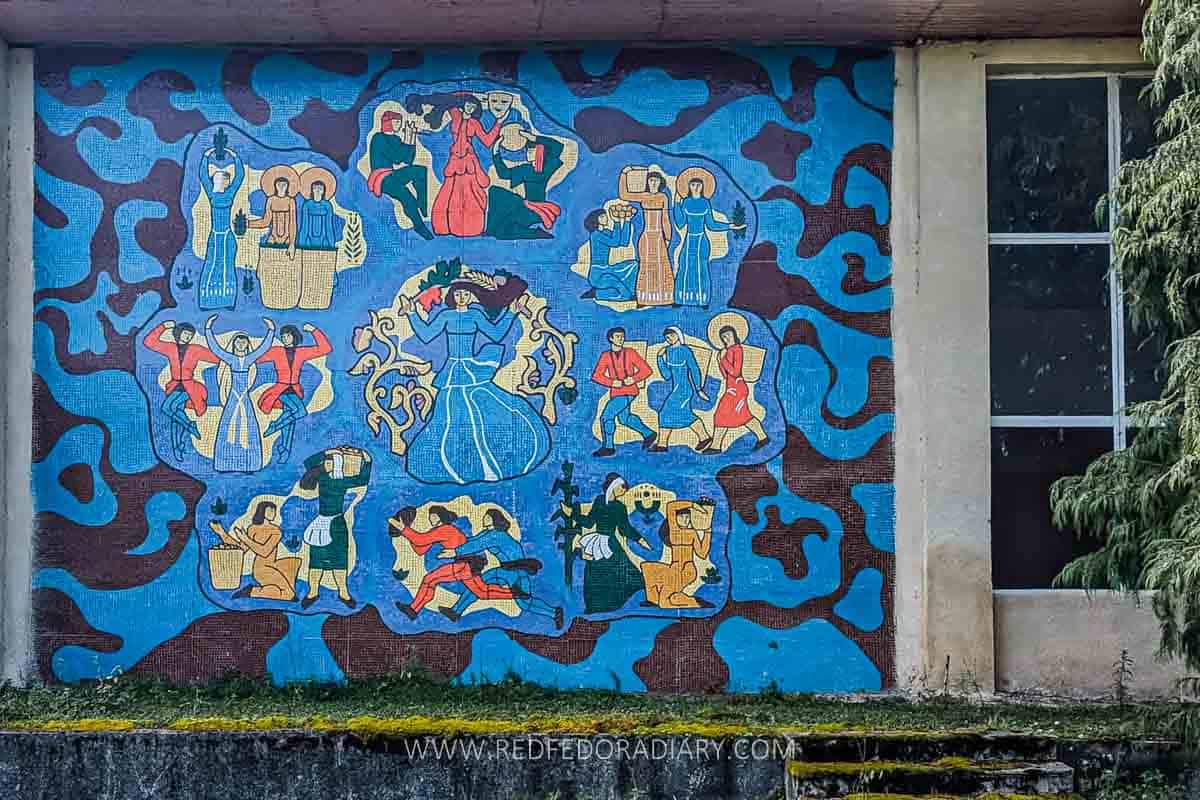
The mosaic on the vivid blue background shows folk and agricultural themes the area is known for, such as tea production, music, citrus, viticulture, and corn.
Seeing Lelo Burti (the 300-year-old brutal ball game) on the mosaic surprised me the most, which I hadn’t seen in any of the mosaics in Guria.
My father told me that Chokhatauri once had a renowned and highly competitive Lelo Burti team. Some photos of the team members are on display at the Local Lore Museum in Chokhatauri.
Further reading: My complete itinerary for Chokhatauri breaks down the best attractions and activities.
Bas-relief on Marine Station in Batumi
Batumi Marine Station is home to a beautiful pastel-colored bas-relief adorning the side wall of the entrance.
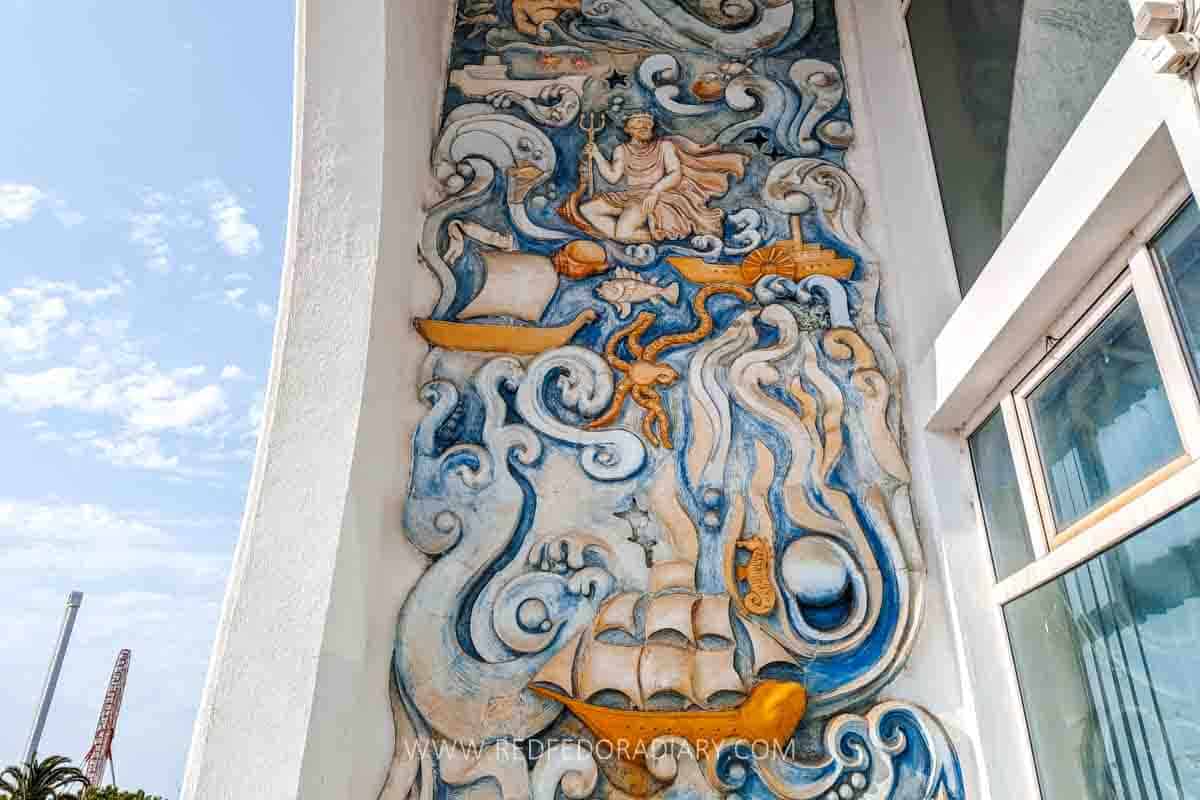
This intricately designed piece showcases an array of sailing ships, ferries, and oceanic motifs, with the prominent figure of Poseidon at its center.
Further reading: There are dozens of bas-reliefs and Soviet mosaics in Batumi, so refer to my detailed Batumi city guide to help you find them.
Underwater World Fountain in Kobuleti
Kobuleti Central Park is home to a gorgeous seaworld-themed massive fountain showcasing different three-dimensional fish, octopuses, and crabs.
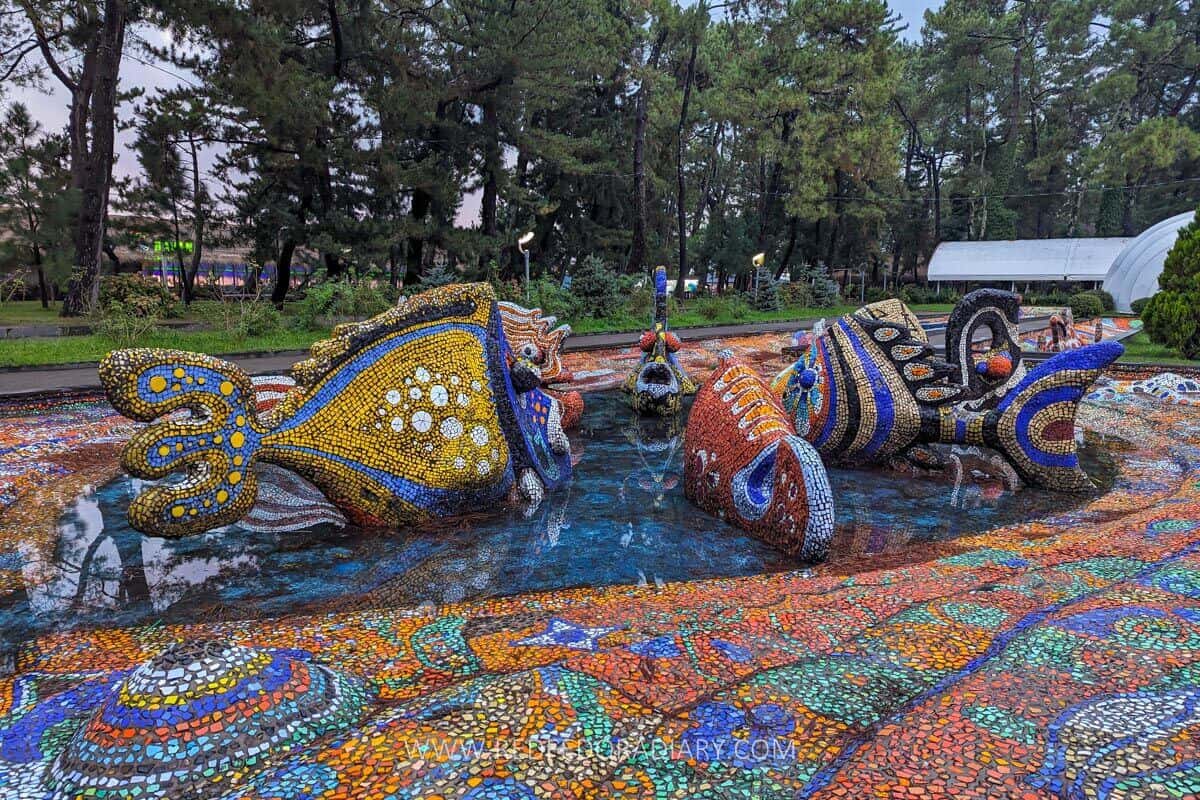
It is very similar to Batumi’s “Octopus” mentioned above. Unfortunately, I found only information about its author, Ilia Pesvianidze. The date is unknown.
Further reading: Unlike Batumi, Kobuleti is a quiet Black Sea coast town with a few mosaics and Soviet-era relics, among other interesting landmarks.
Mosaic-covered amphitheater in Poti (Samegrelo)
Another favorite Soviet-era mosaic is in Poti’s Central Park grounds. This curved amphitheater’s interior portrays a girl and a boy playing traditional Georgian musical instruments, wearing traditional clothes, and surrounded by flowers, animals, and birds.
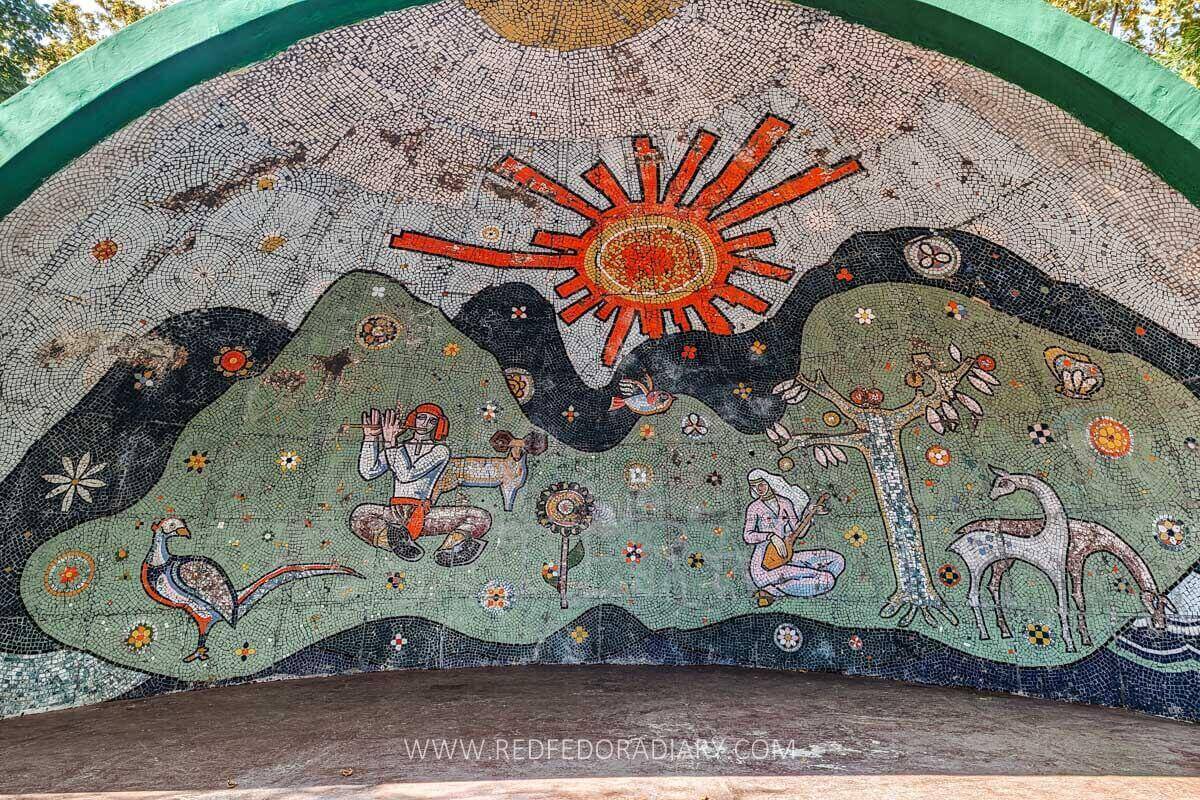
World War II Memorial near Poti (Samegrelo)
While World War Memorials are not my cup of tea in most cases, I still enjoy finding those that are unique and different from the usual memorials that look more tragic or patriotic. And the one in Poti is exactly that.
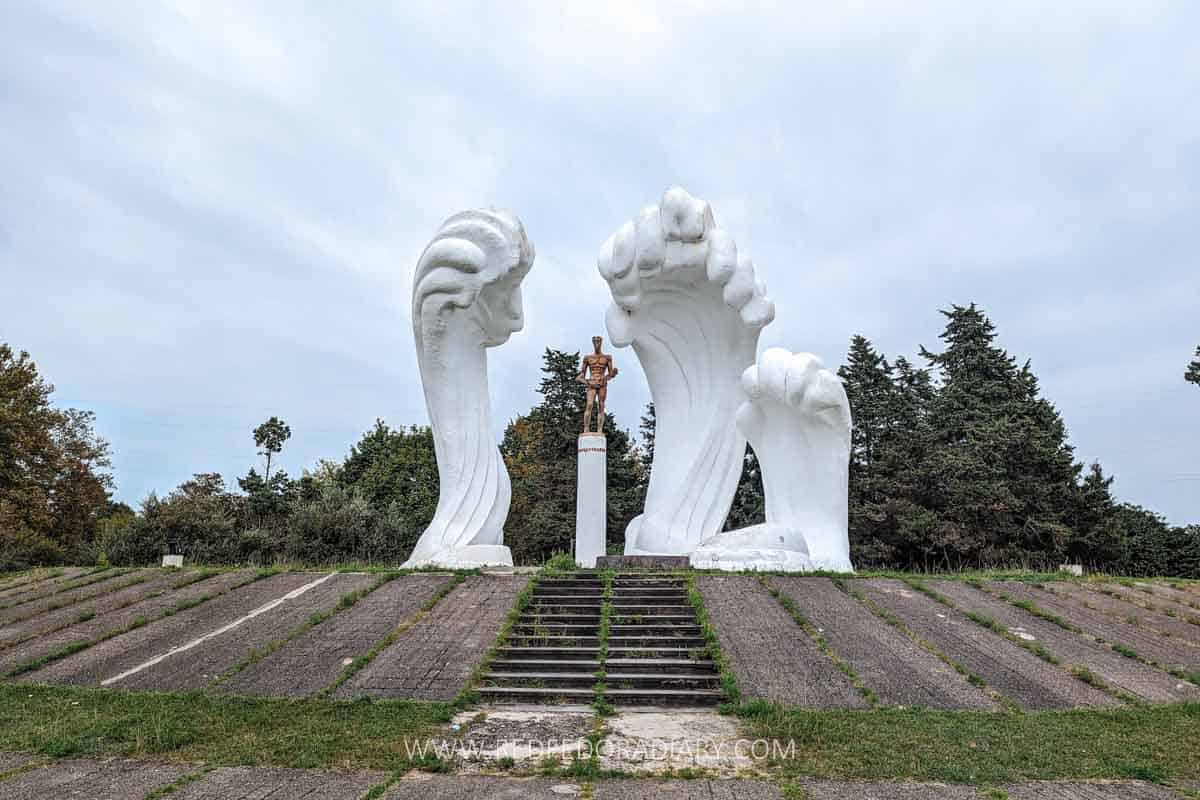
The memorial, placed on the main highway to/from Poti and named Monument to Heroes-Sailors, pays homage to fallen WWII soldiers and sailors.
It features a golden figure resembling David on top of the column, with three towering white shapes that look like crashing waves or fists, adding an intriguing dimension.
Created by sculptor Elguja Amashukeli and architect Vagtang Davitaya in 1979, the area also has large stone pieces surrounding the sculpture, bearing the names of the fallen.
Further reading: My ultimate guide to Poti will help you plan your visit with ease. It has everything you need to make the most of your trip.
BONUS: Soviet-related resources for further reading/listening
CCCP: Cosmic Communist Constructions Photographed” by Frédéric Chaubin
This visually stunning book showcases 90 Soviet-era buildings constructed between 1970 and 1990, highlighting their futuristic and often surreal designs. From brutalist concrete structures to sci-fi-inspired government buildings, Chaubin’s photography captures the ambition and eccentricity of late Soviet architecture. Order on Amazon.
Reimagining Soviet Georgia Podcast
This podcast series, produced by a multigenerational, multilingual collective based in Tbilisi, is my recent discovery. It aims to reexamine and reinterpret the history of Soviet Georgia. It features critical research, oral histories, and discussions, offering diverse perspectives on the country’s past. Listen on Spotify.
Ajam Podcast #5: Urbanism & Informality in Post-Soviet Tbilisi
This episode delves into the transformation of Tbilisi from a medieval walled city to its current state, discussing its evolution through Tsarist, Soviet, and post-Soviet periods. The conversation highlights how these historical phases have shaped the city’s urban landscape and architecture. Listen here.
Georgian and Soviet: Entitled Nationhood and the Specter of Stalin in the Caucasus by Claire P. Kaiser
The book Georgian and Soviet examines the unique position of Soviet Georgia, which, following the USSR’s nation-building template, also benefited from Stalin’s Georgian heritage. The author explores how this influenced the republic’s architecture and cultural development. Order on Amazon or watch the Book Talk on YouTube.
Moscow: Art for Architecture – Soviet Mosaics from 1935 to 1990 by James Hill, Anna Petrova, and Evgeniya Kudelina
This book offers a comprehensive collection of 140 chronologically organized Soviet-era mosaics in Moscow. It explores various styles—Art Deco, Socialist Realism, Modernism, and Postmodernism—and features works by renowned artists alongside lesser-known creators.
The volume provides insights into the evolution of Soviet art as reflected in Moscow’s architectural adornments. Order on Amazon.
Mosaics of Soviet Period in Georgia by Nini Palavandishvili (Available in bookstores in Georgia)
This book is the first dedicated collection of Soviet-era mosaics in Georgia, showcasing works from the late 1960s to the 1980s. It highlights the artistic diversity of these monumental-decorative mosaics, from their themes and materials to their placement in urban and rural landscapes.
Life in Soviet Georgia (Available in bookstores in Georgia)
This collection of 70 personal stories offers a profoundly human perspective on life in Soviet Georgia, told by 70 authors who lived through it. Each story represents a year of the USSR’s existence, capturing moments of joy, fear, resilience, and absurdity in a system built on contradictions.
